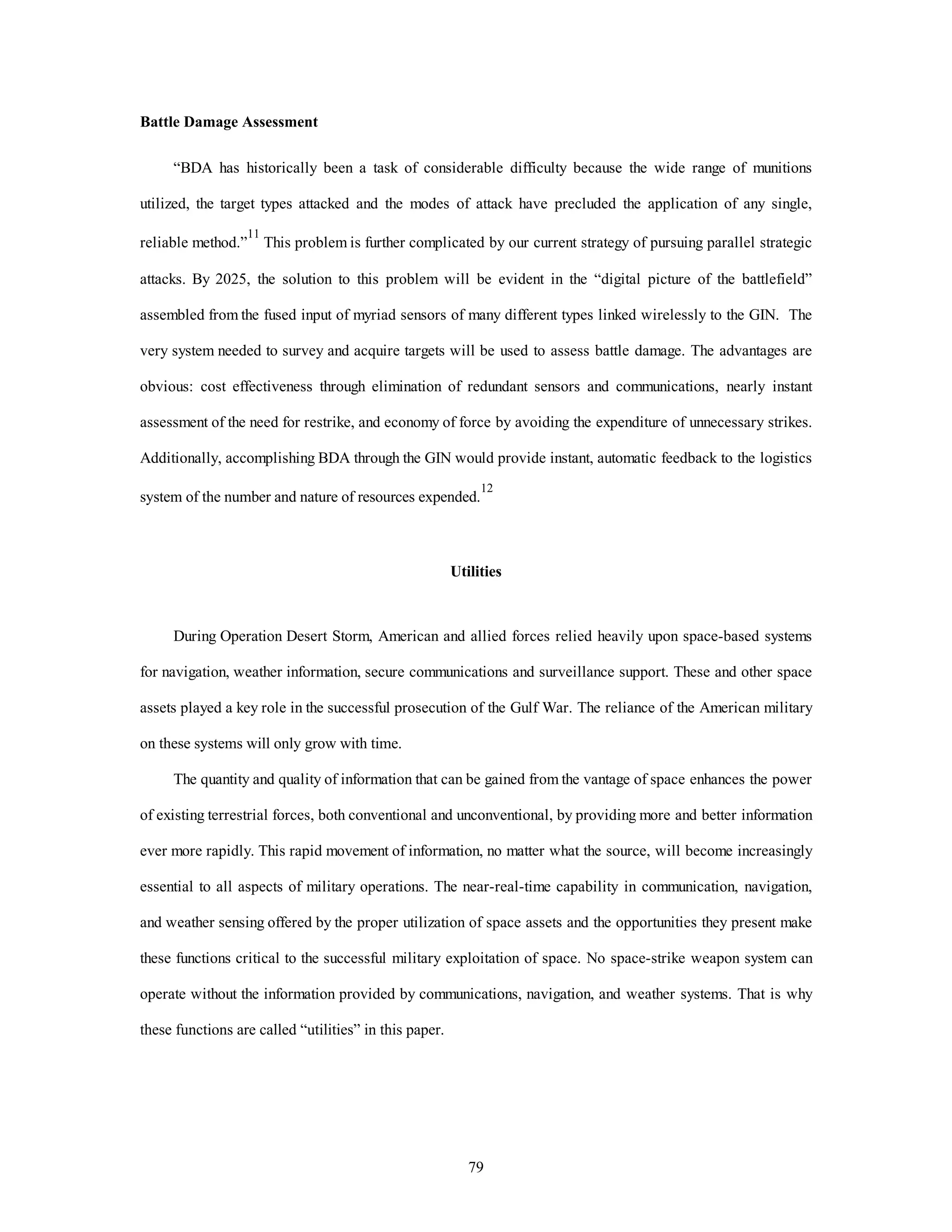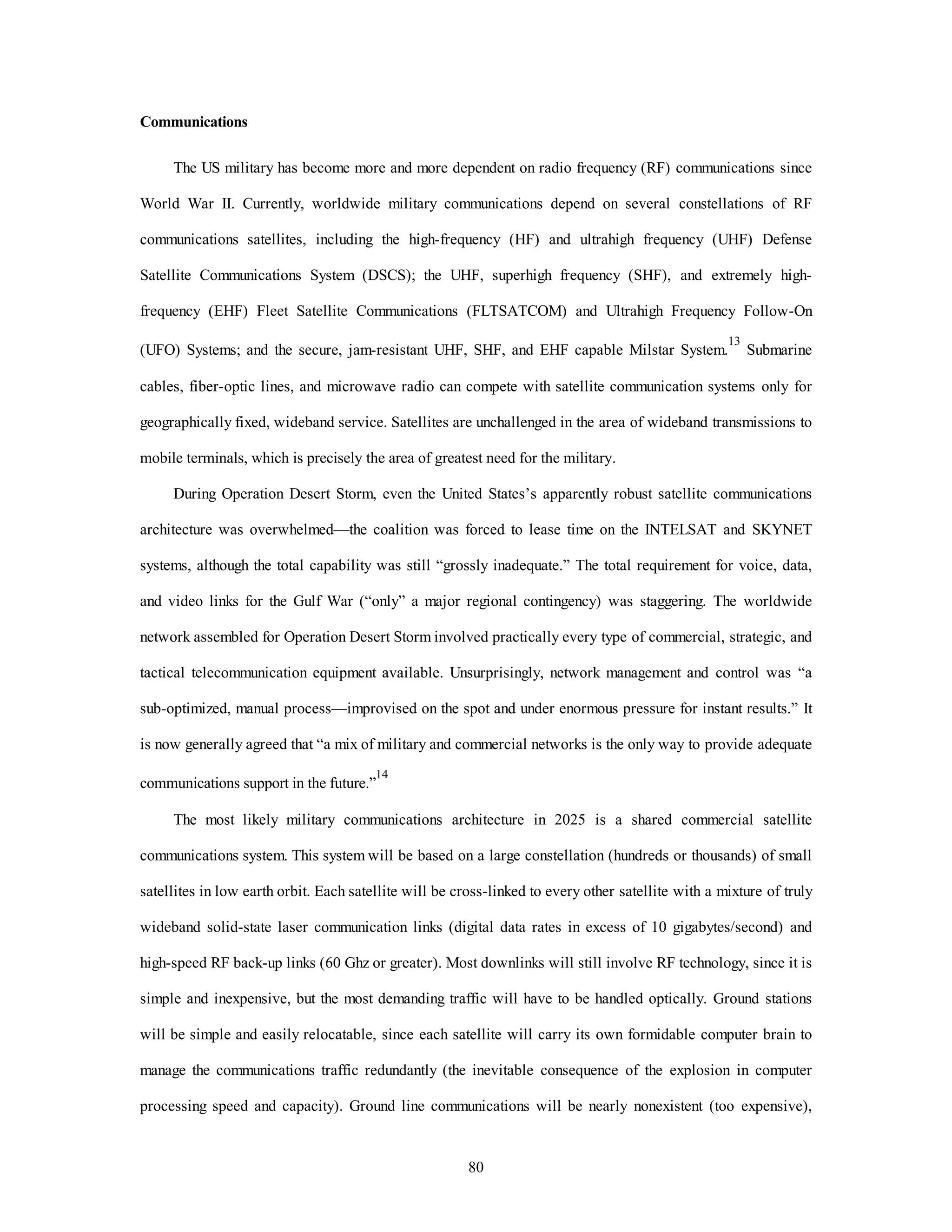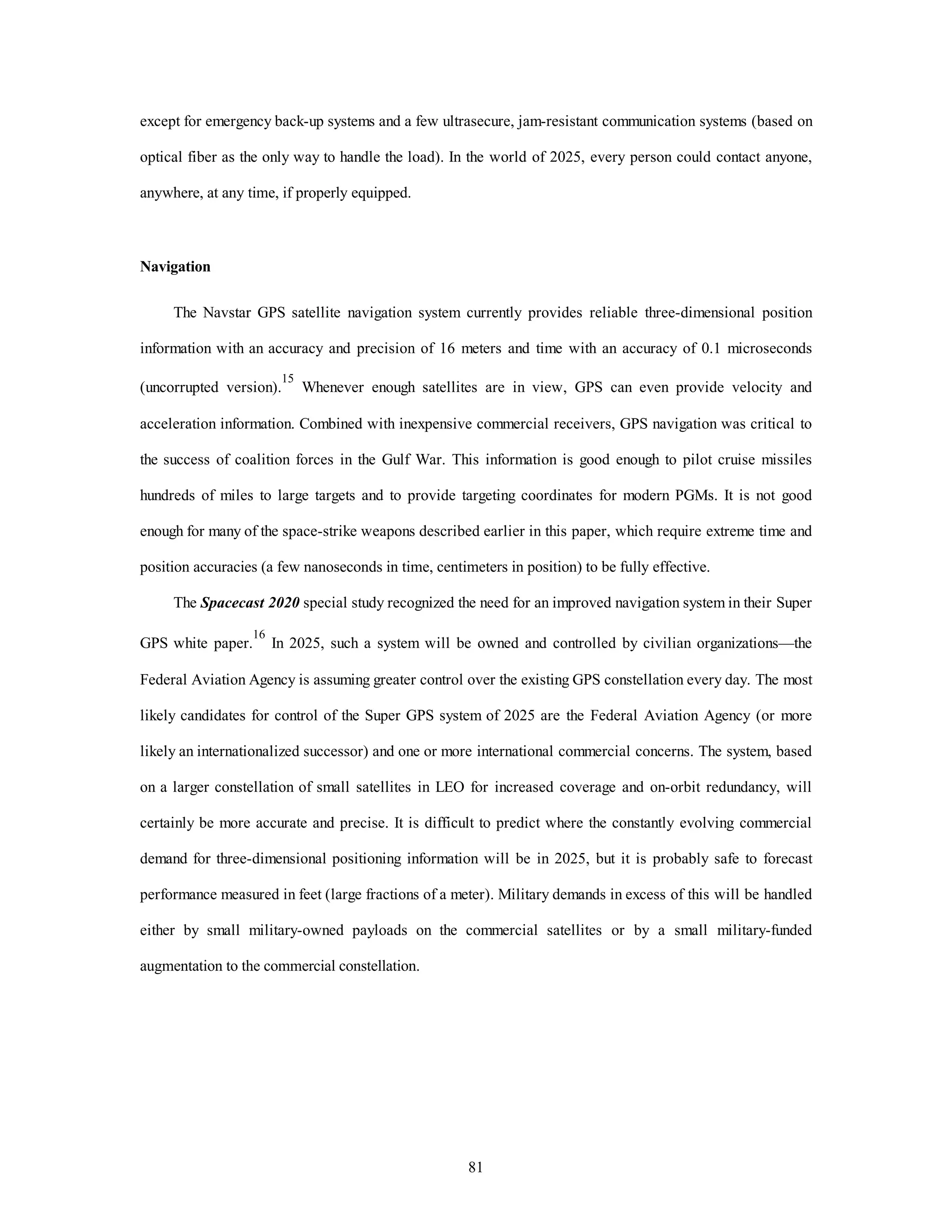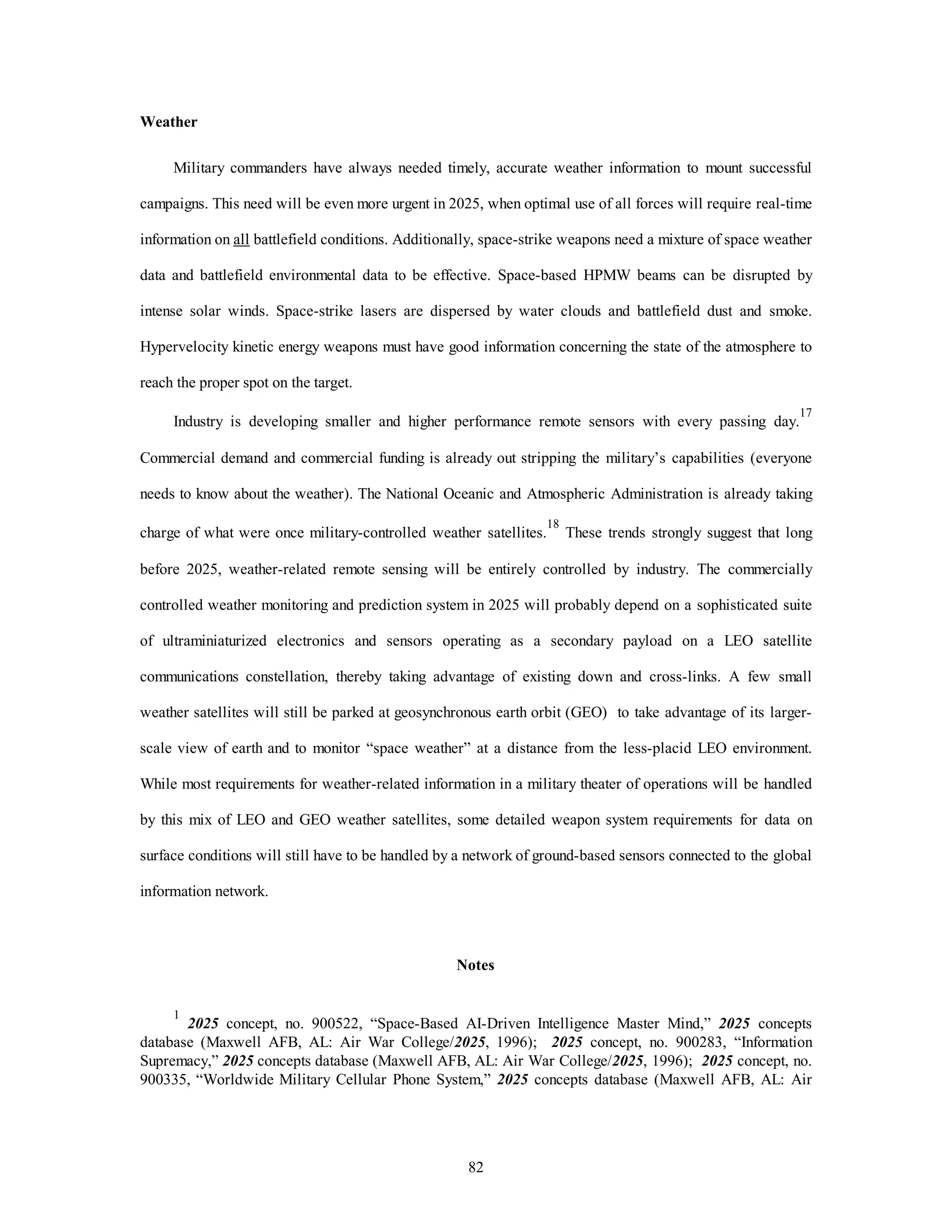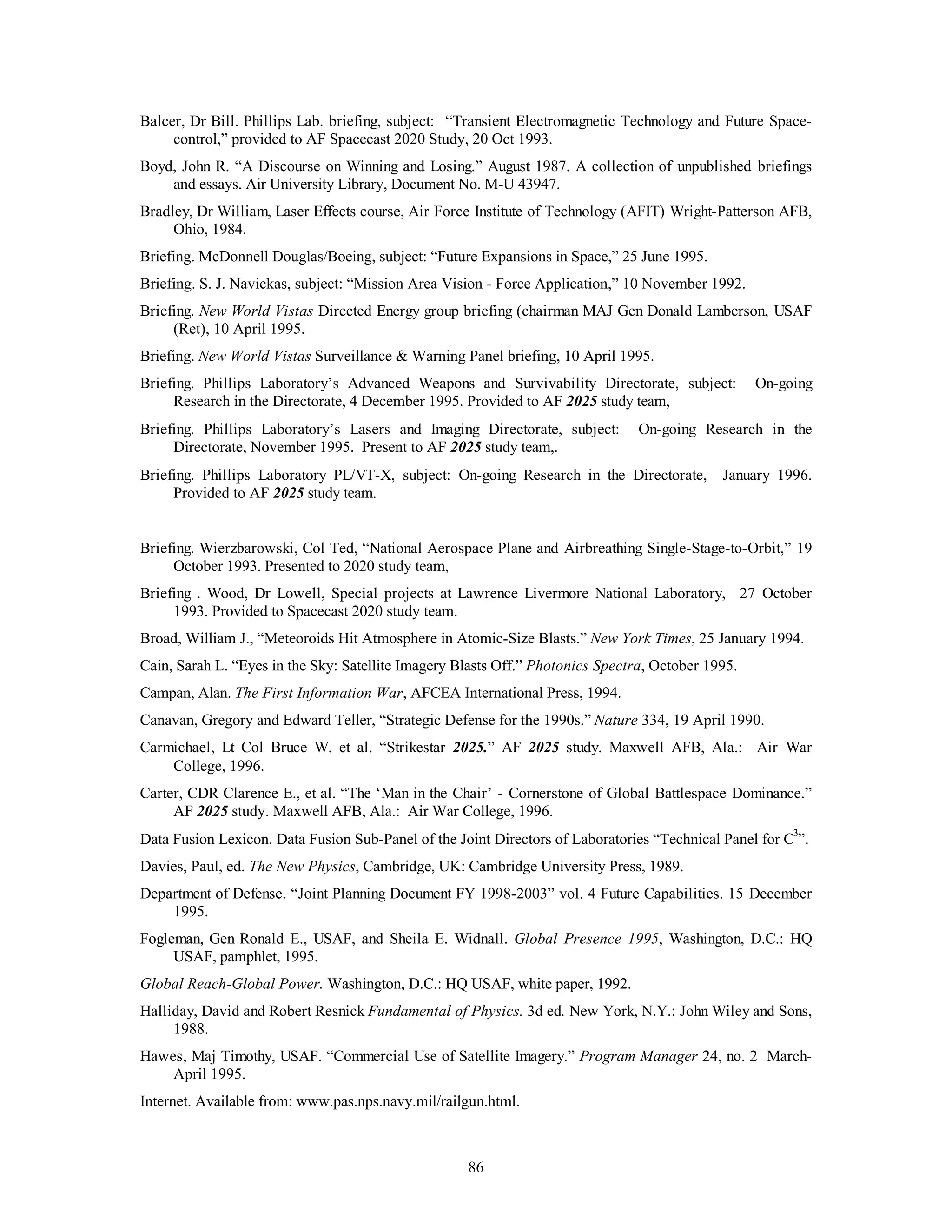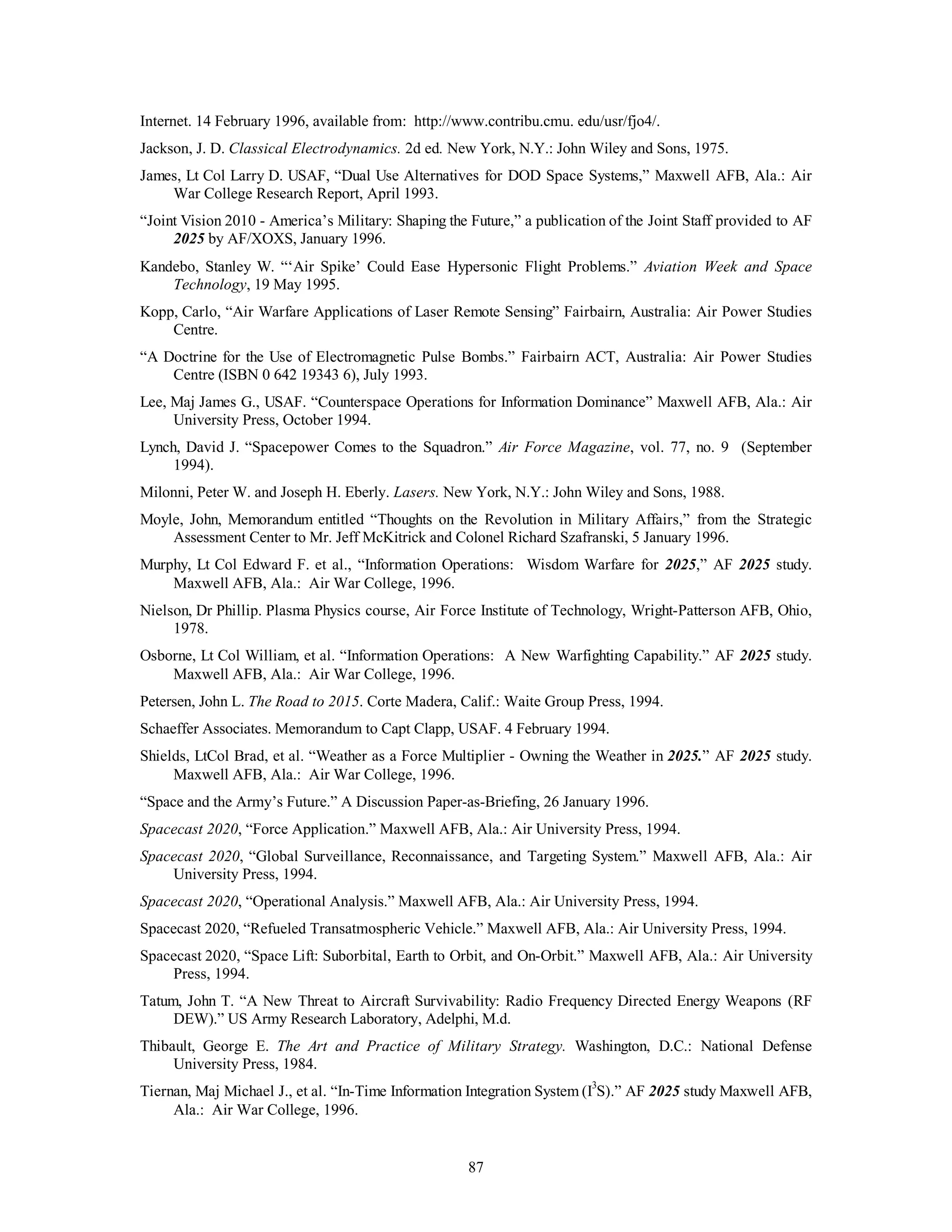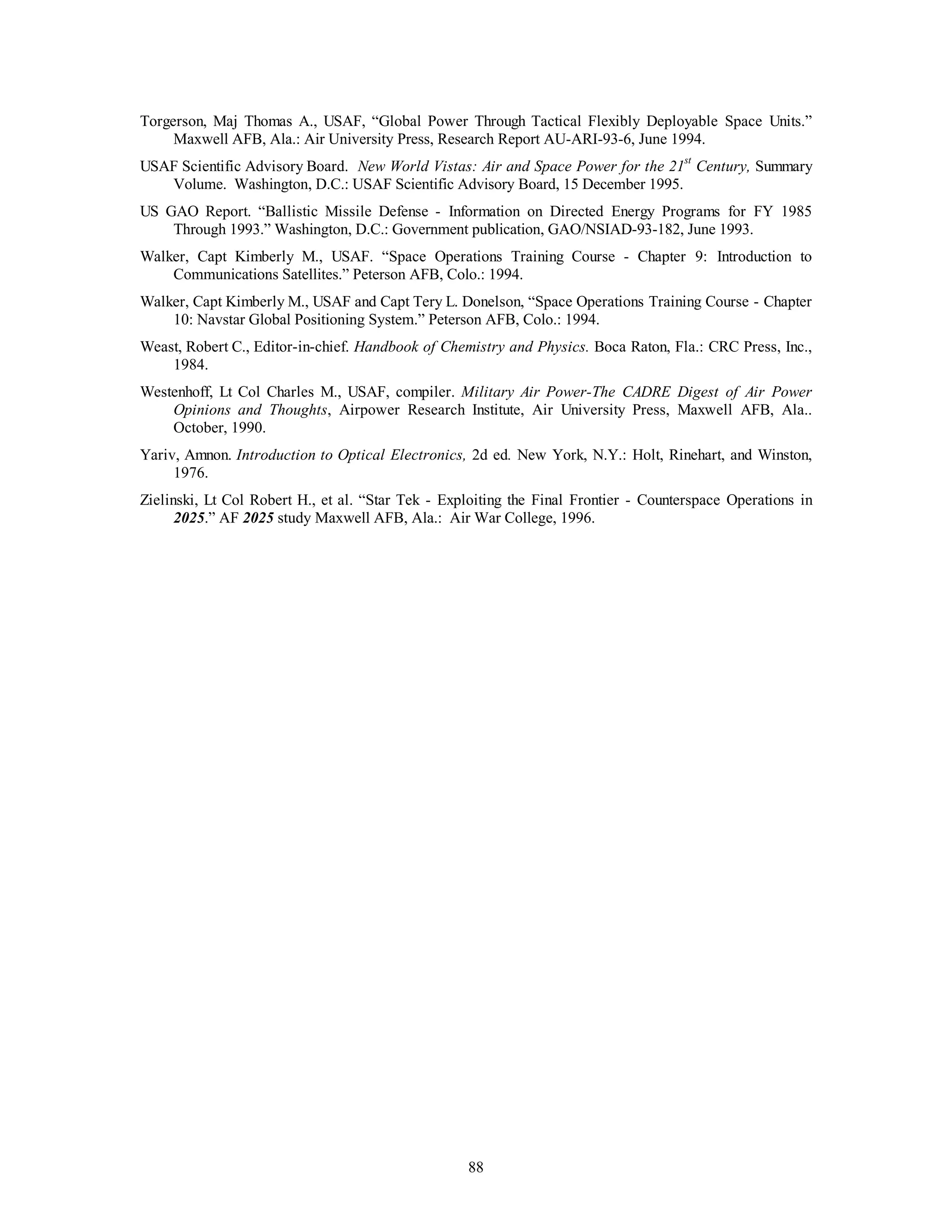This document presents a research paper on space operations and a potential future system called the Global Area Strike System (GASS). It discusses issues around space operations in 2025, including manned vs unmanned systems and military vs cooperative operations. It then outlines the required capabilities for GASS, including timeliness, responsiveness, flexibility, and precision. It proposes an integrated system-of-systems for GASS using various weapon platforms and classes, including directed energy weapons, projectile weapons, and a transatmospheric vehicle. It concludes with concept of operations and recommendations.

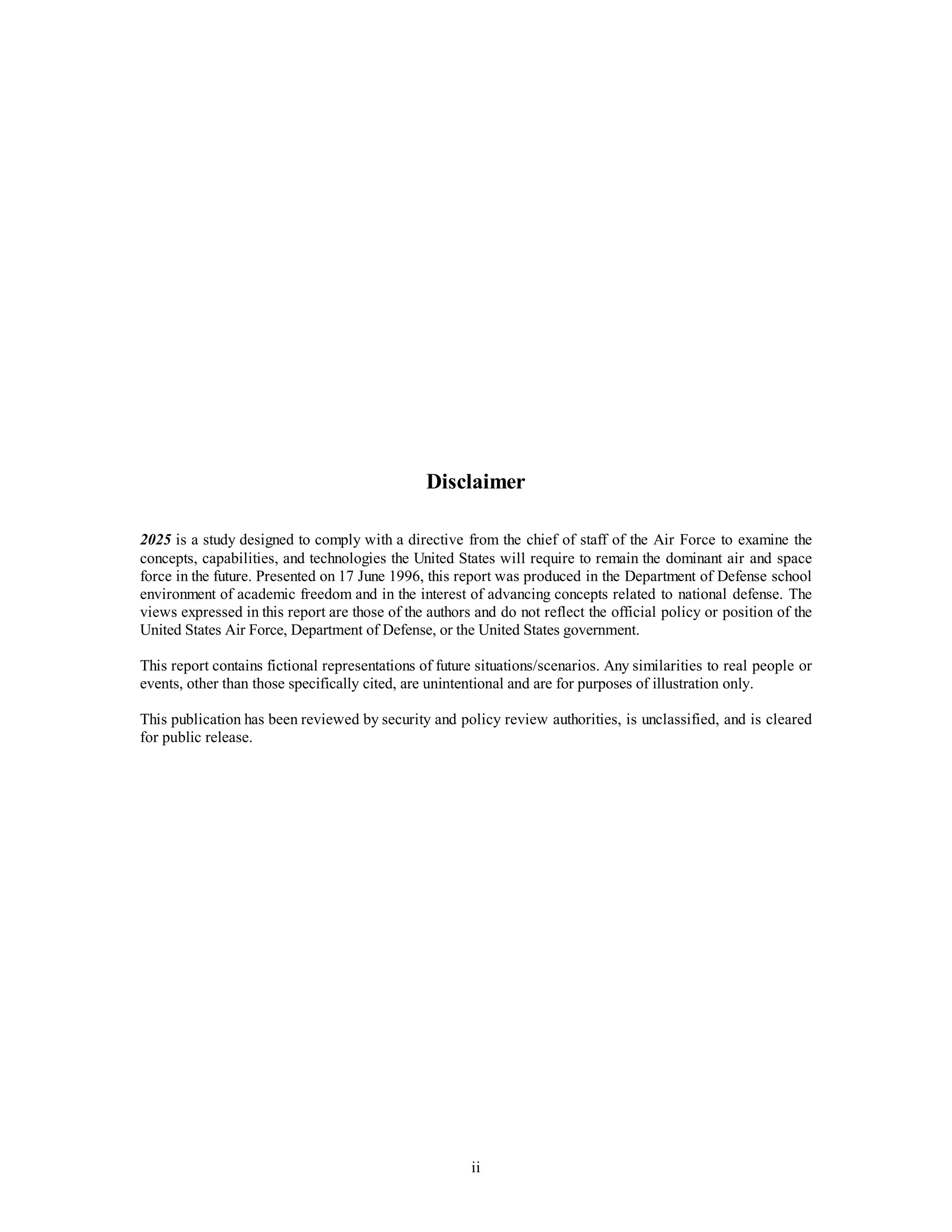
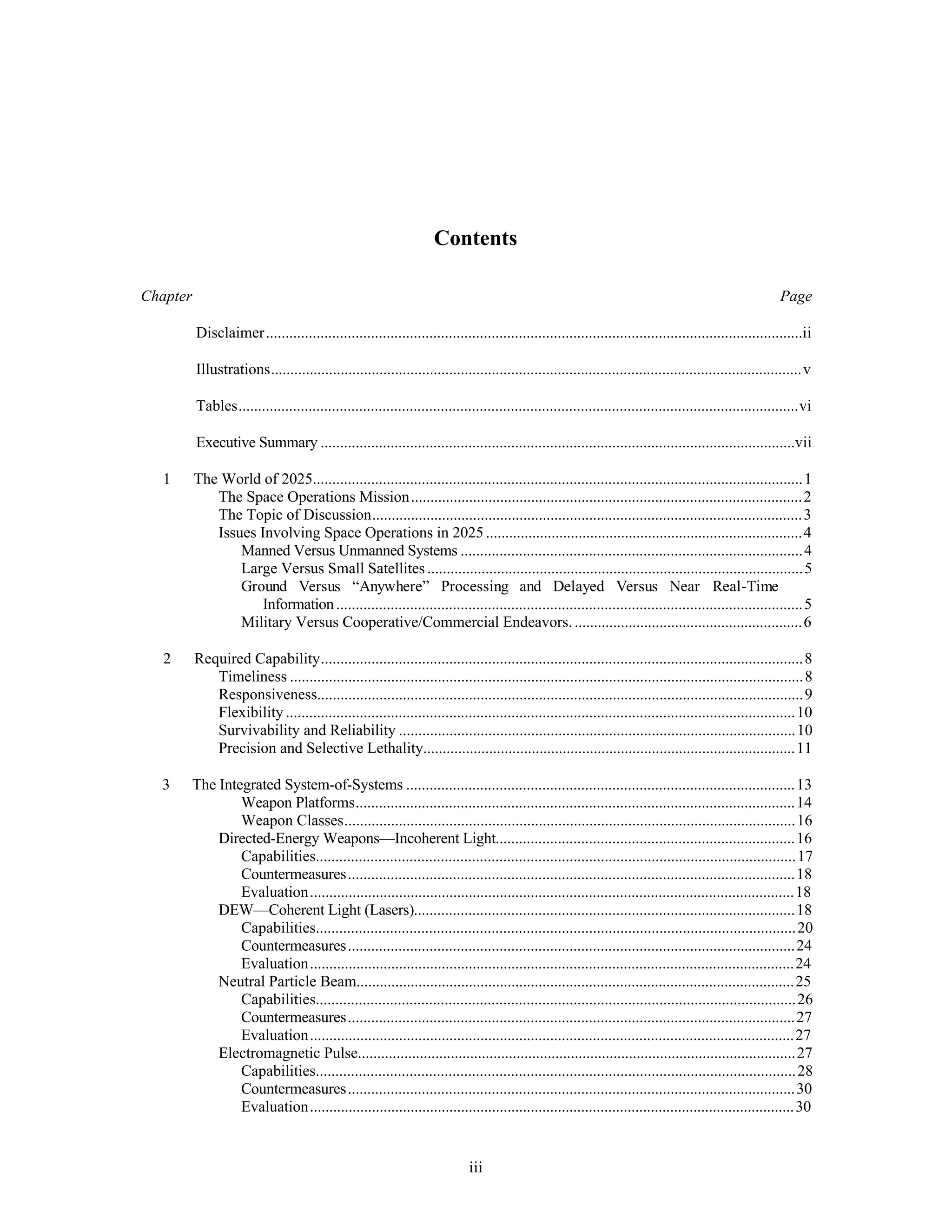
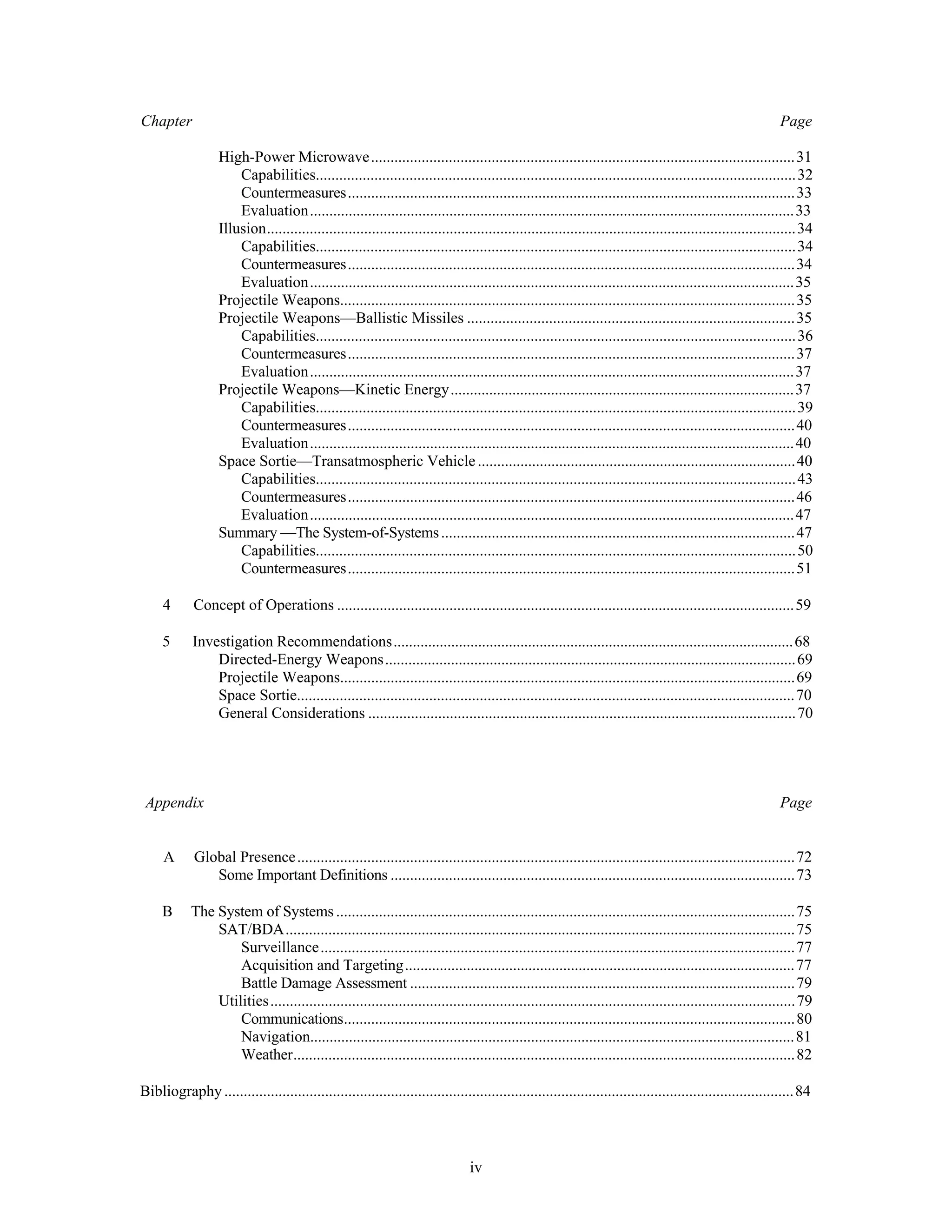
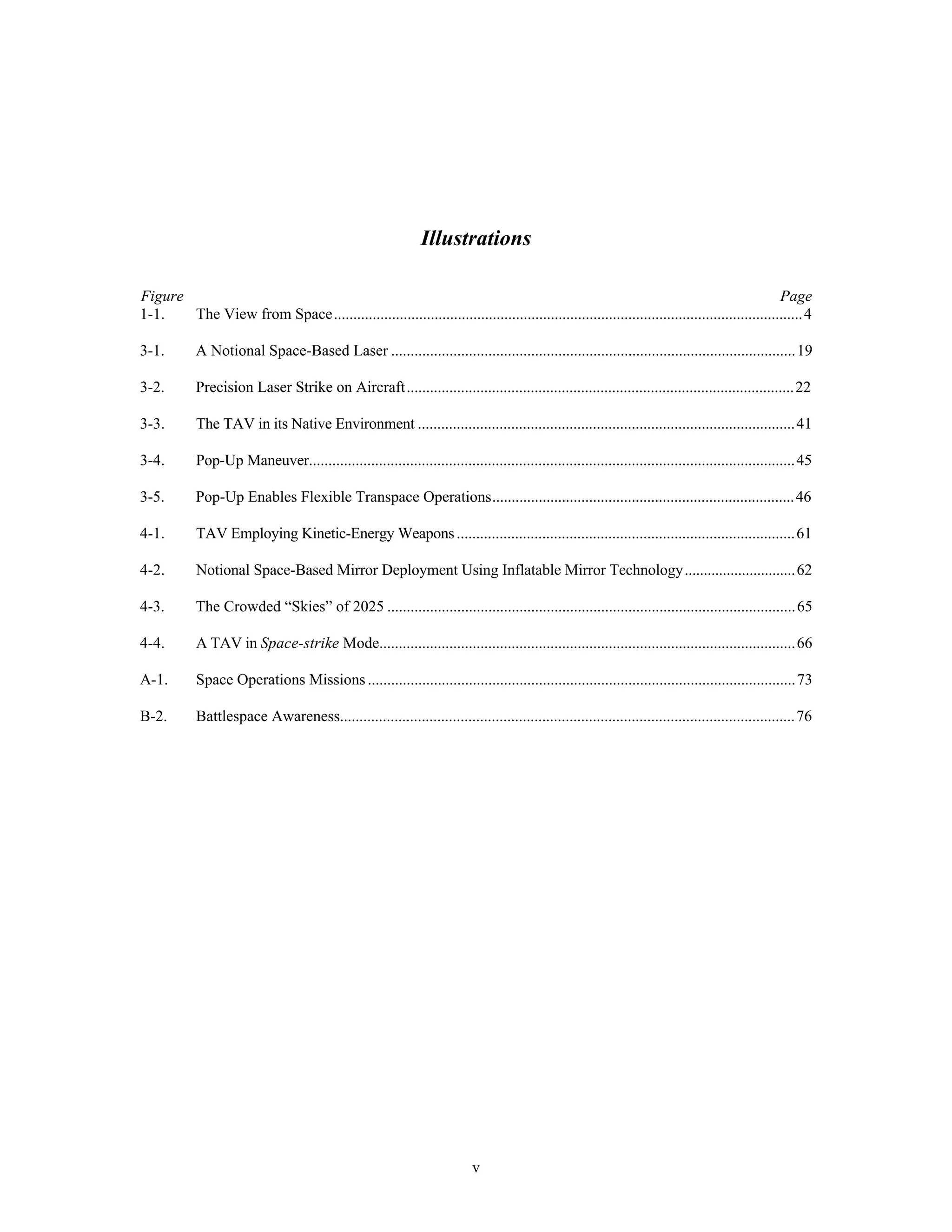

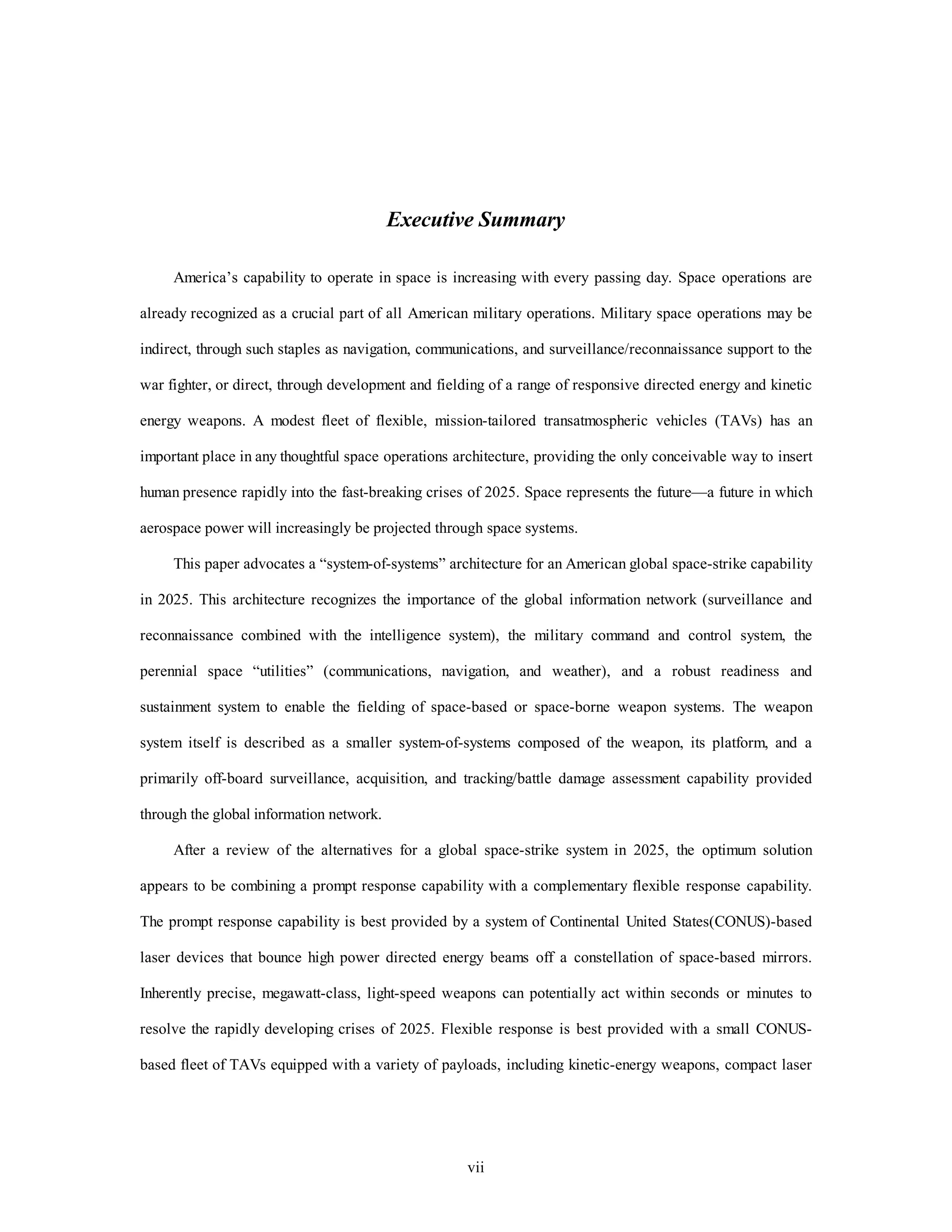
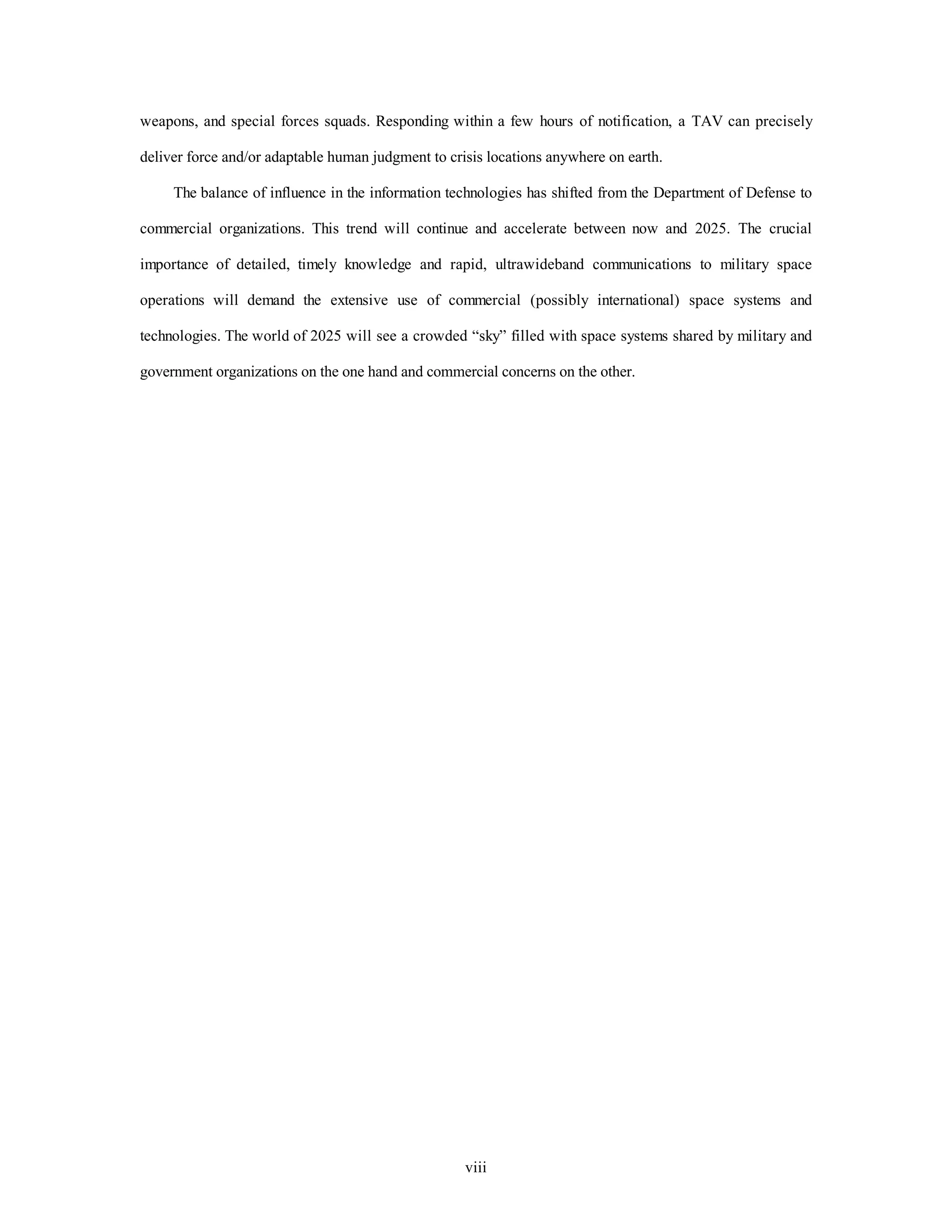

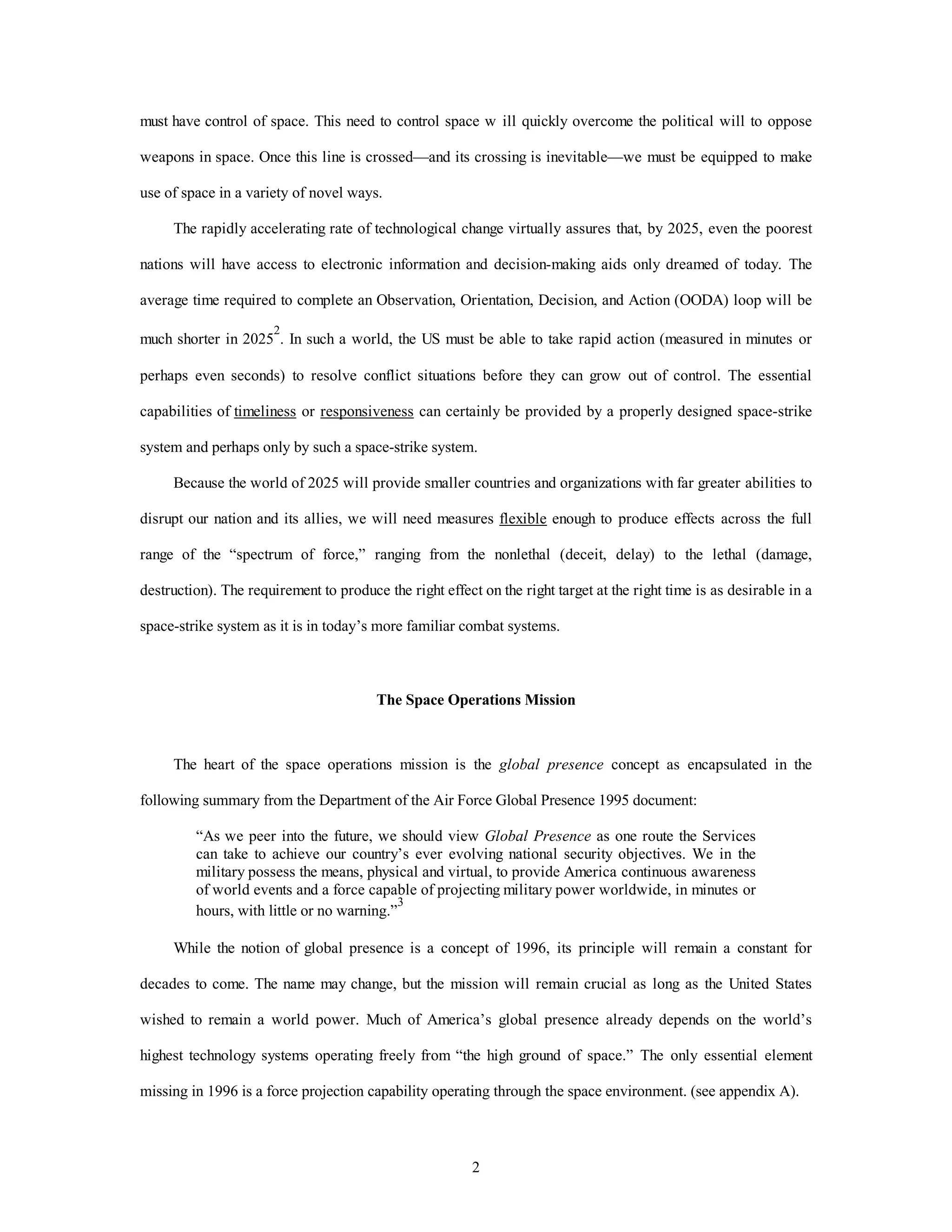
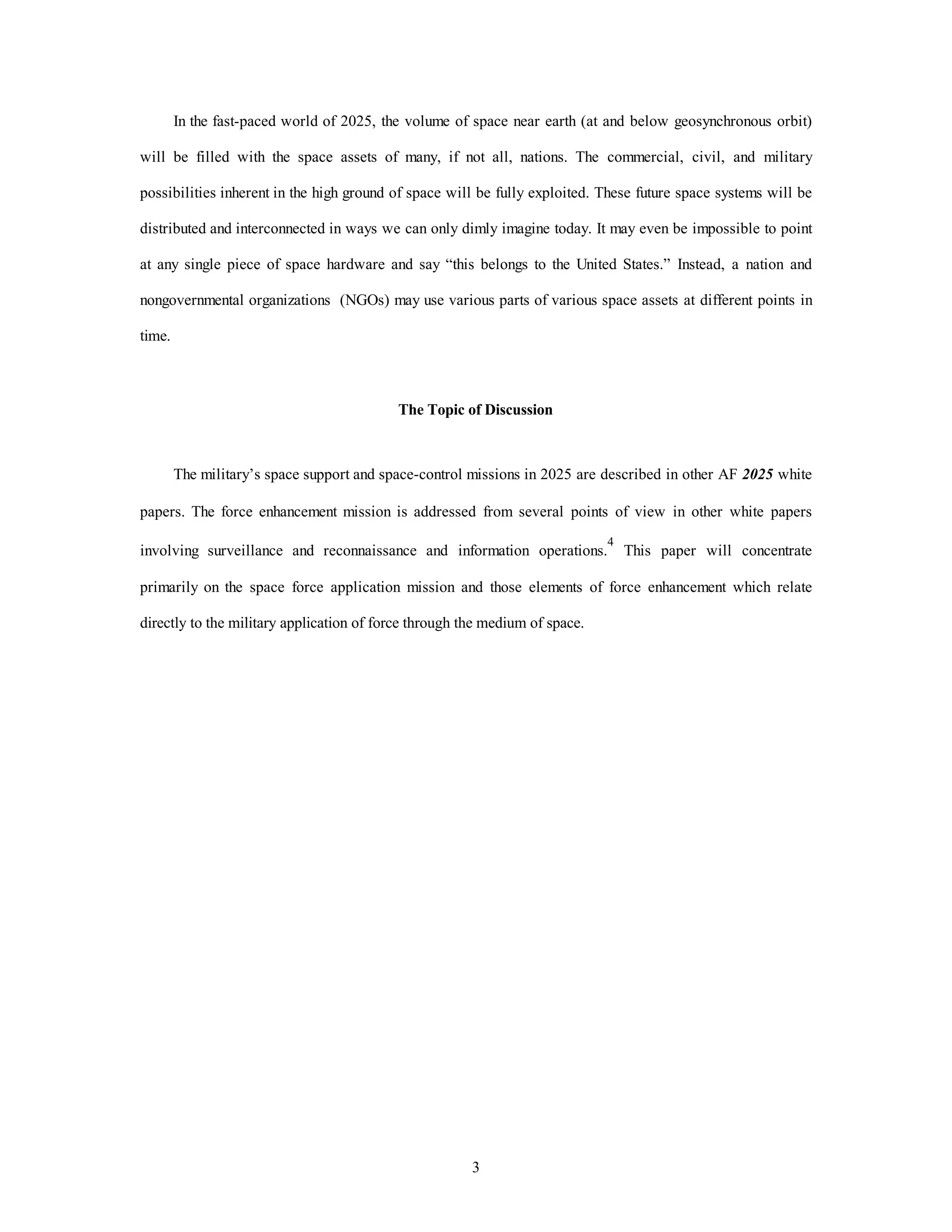
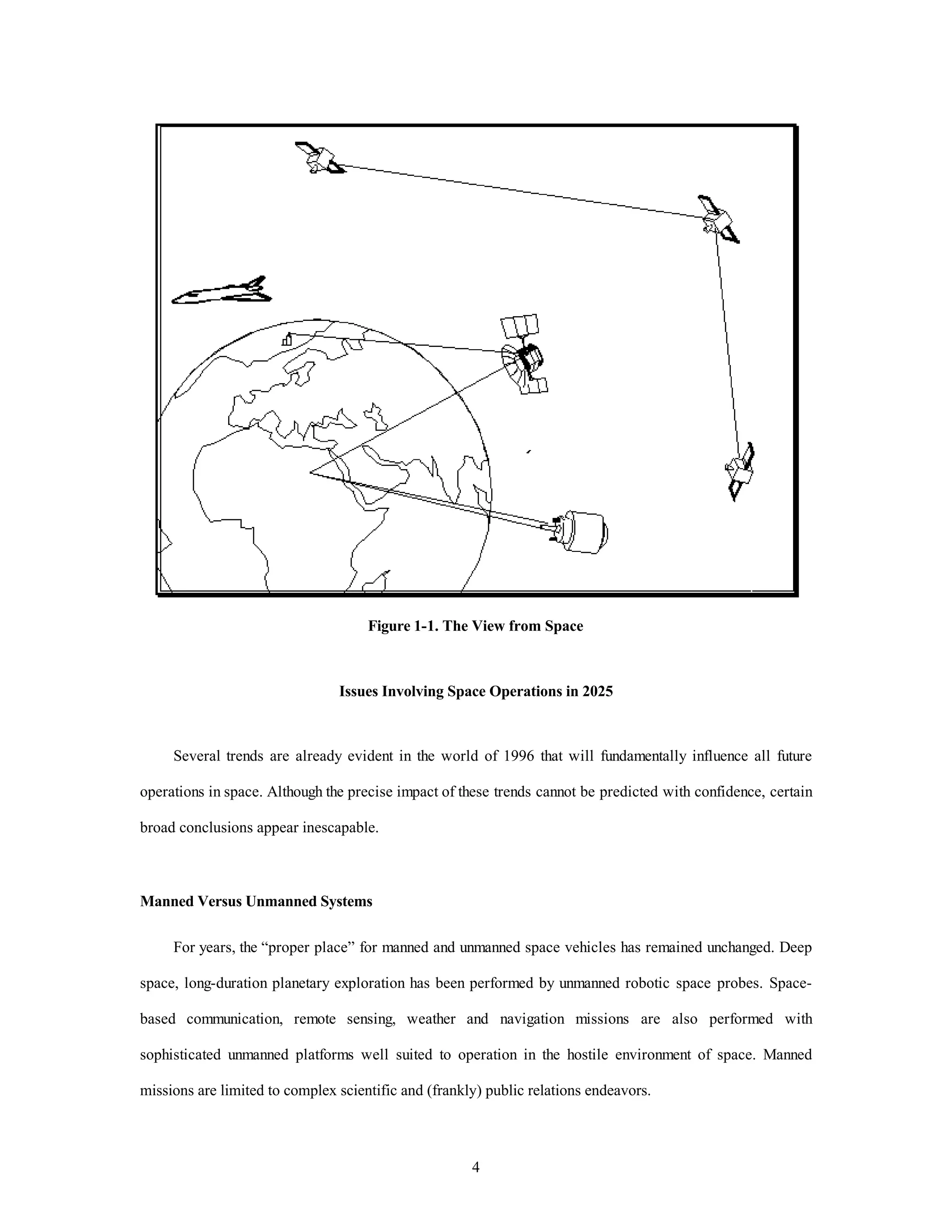
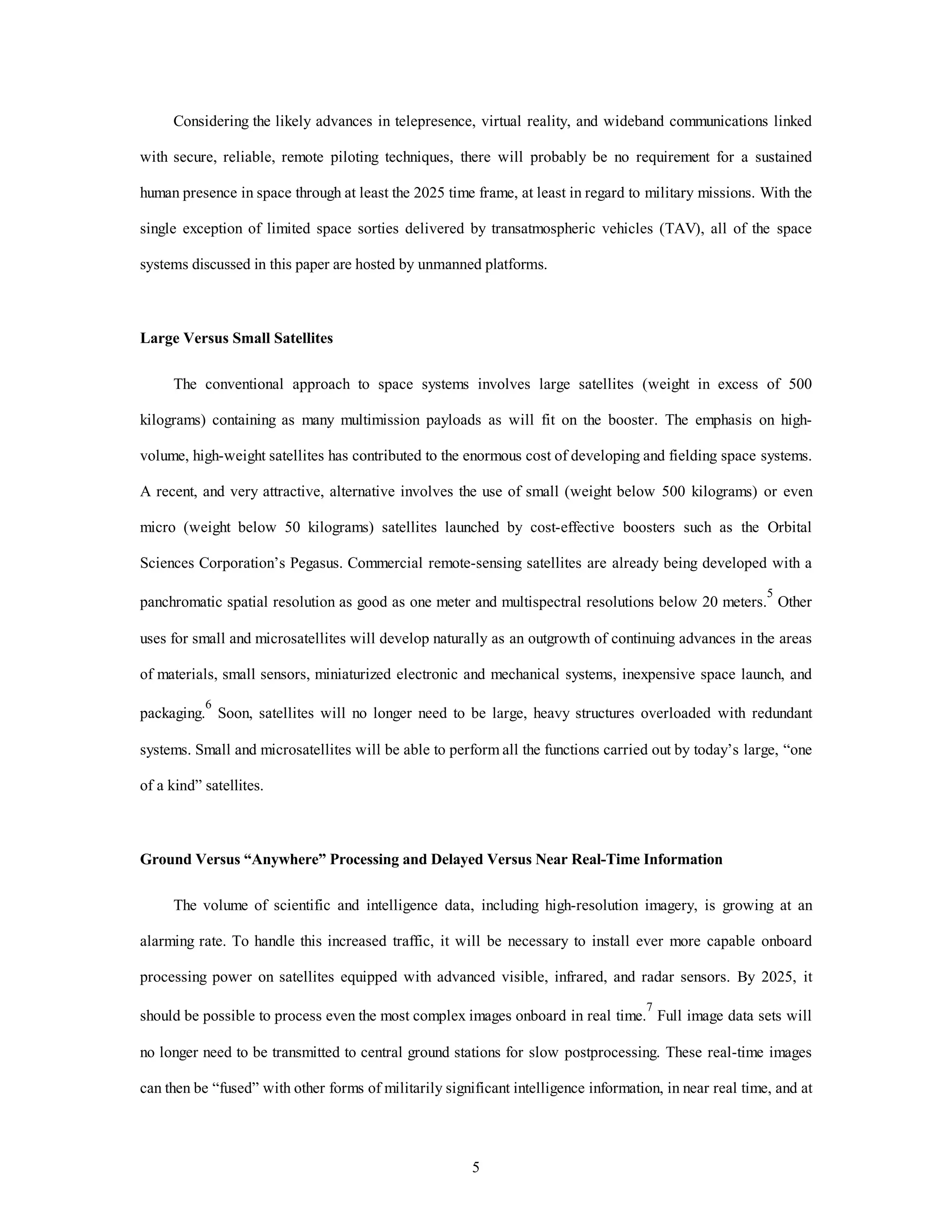
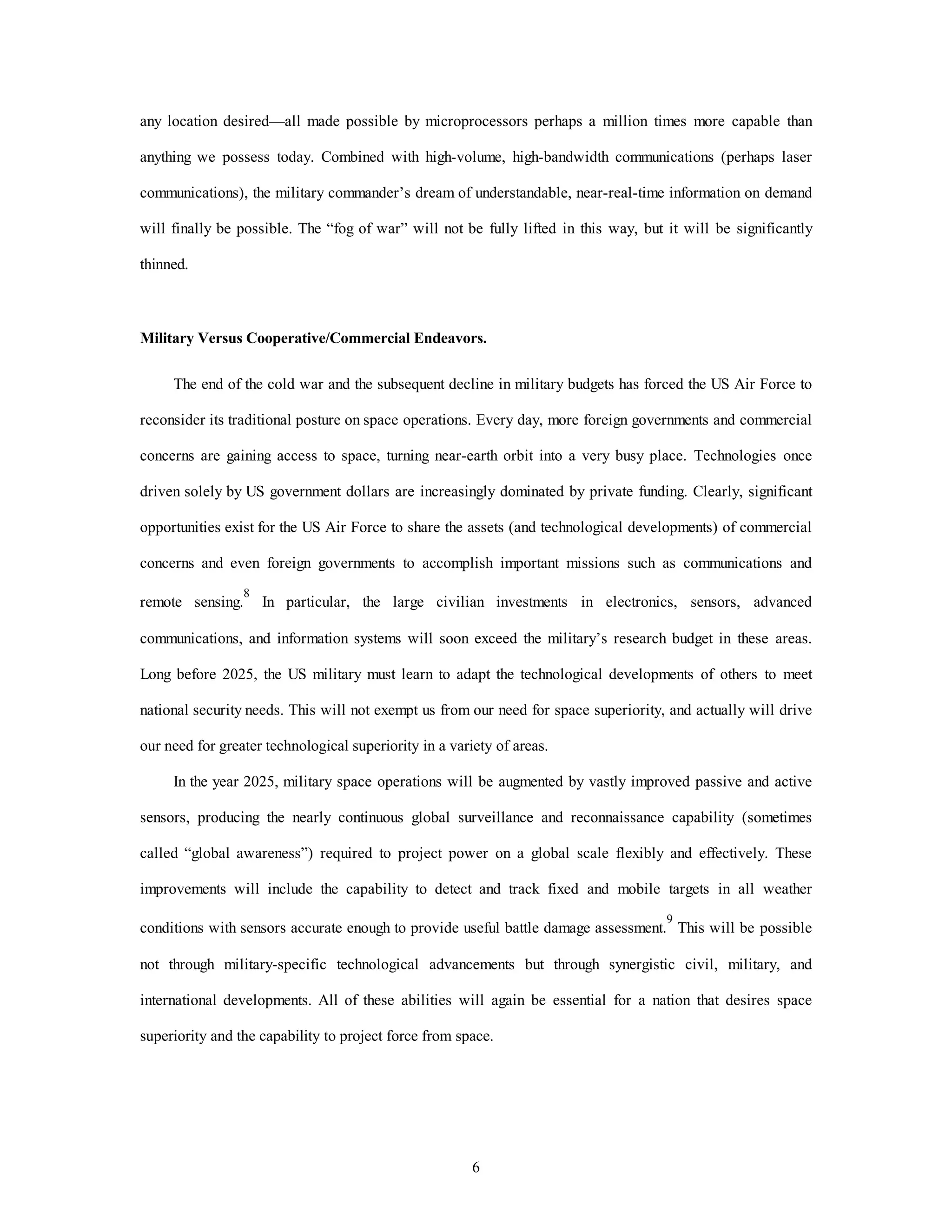
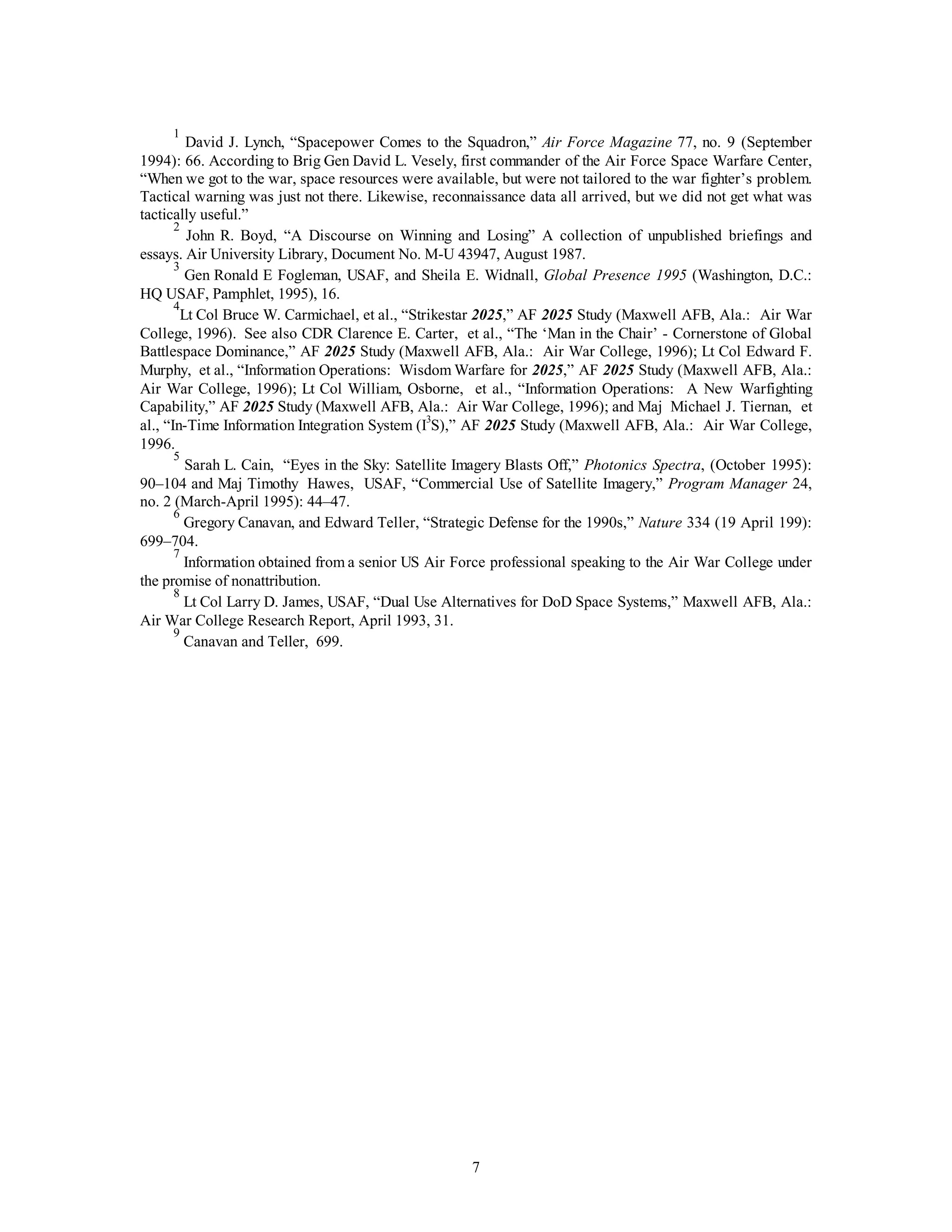
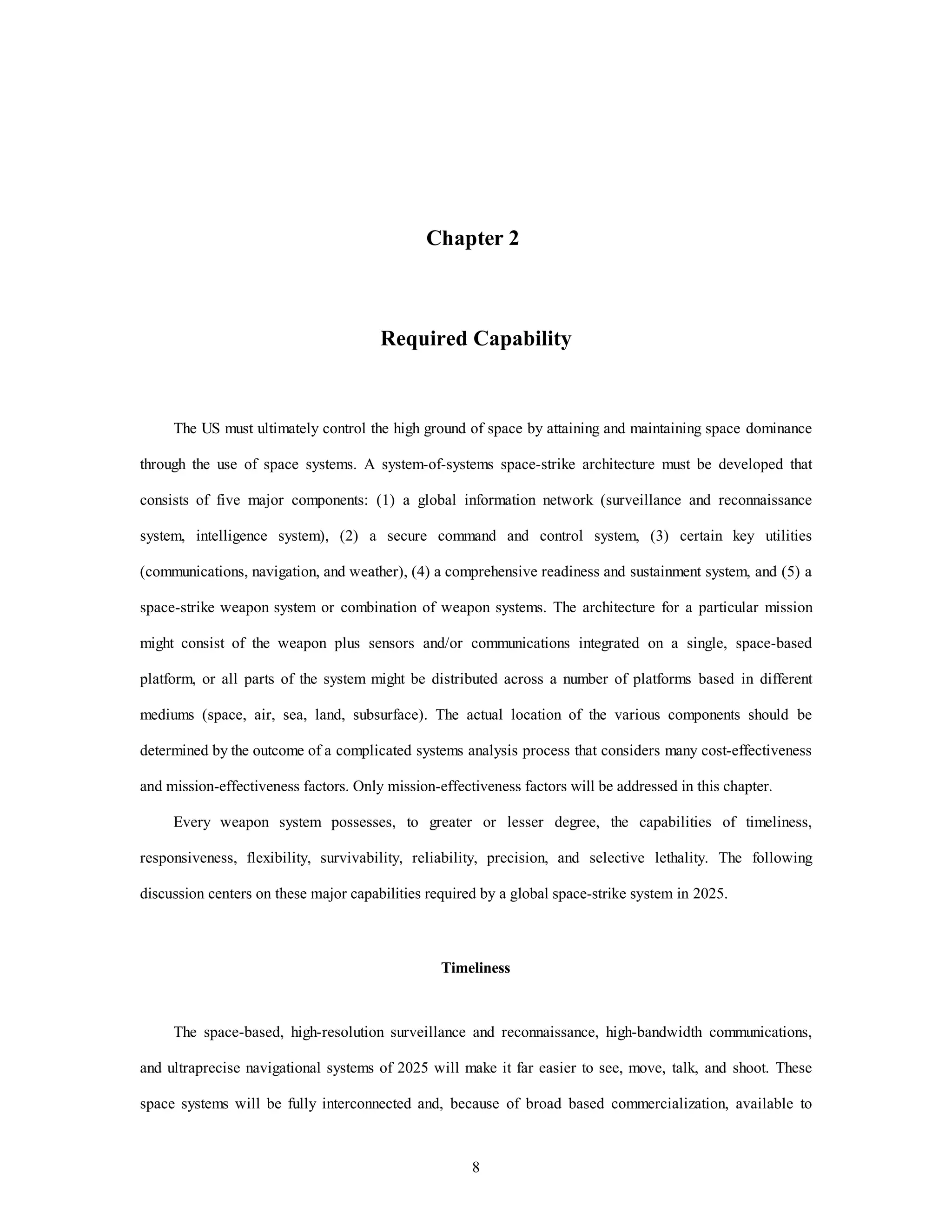




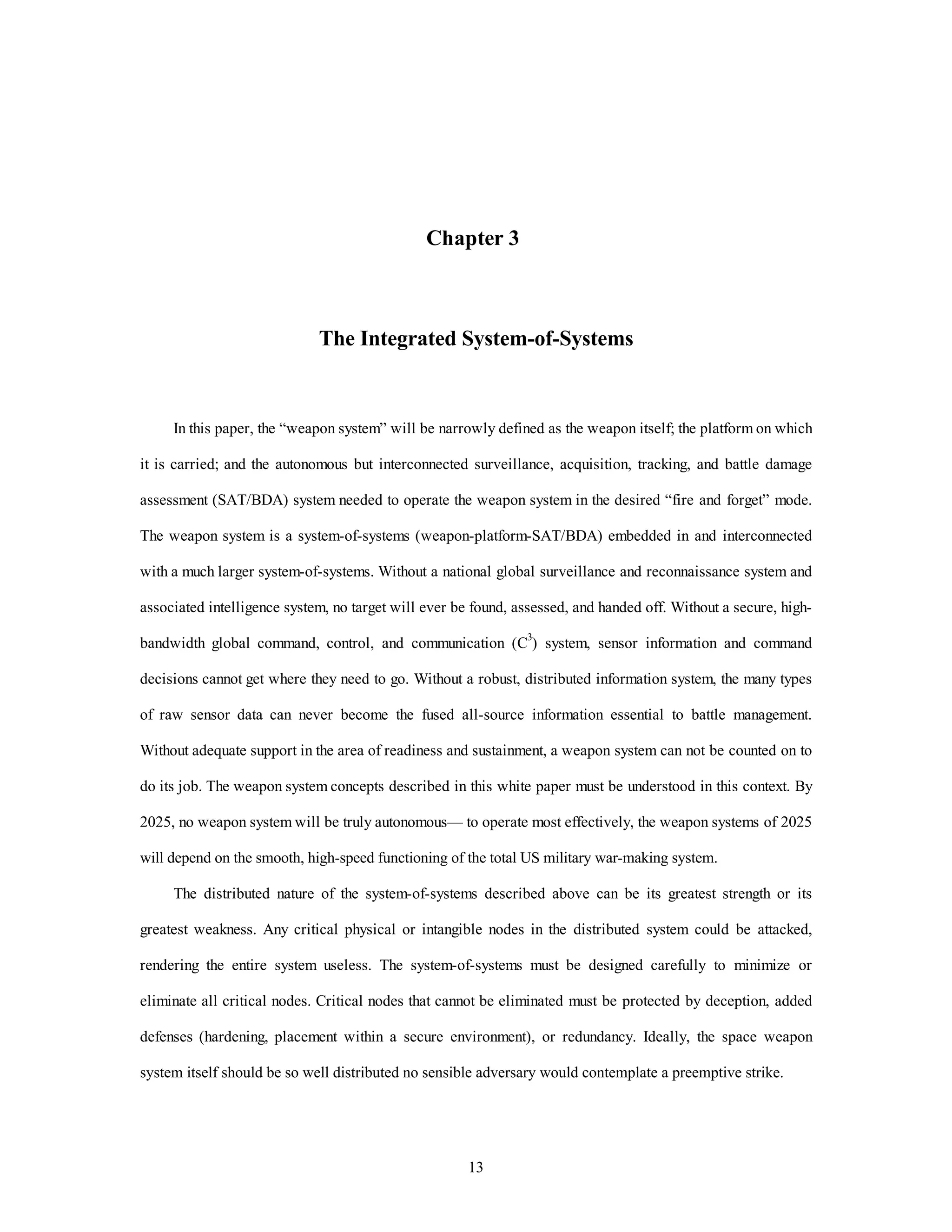
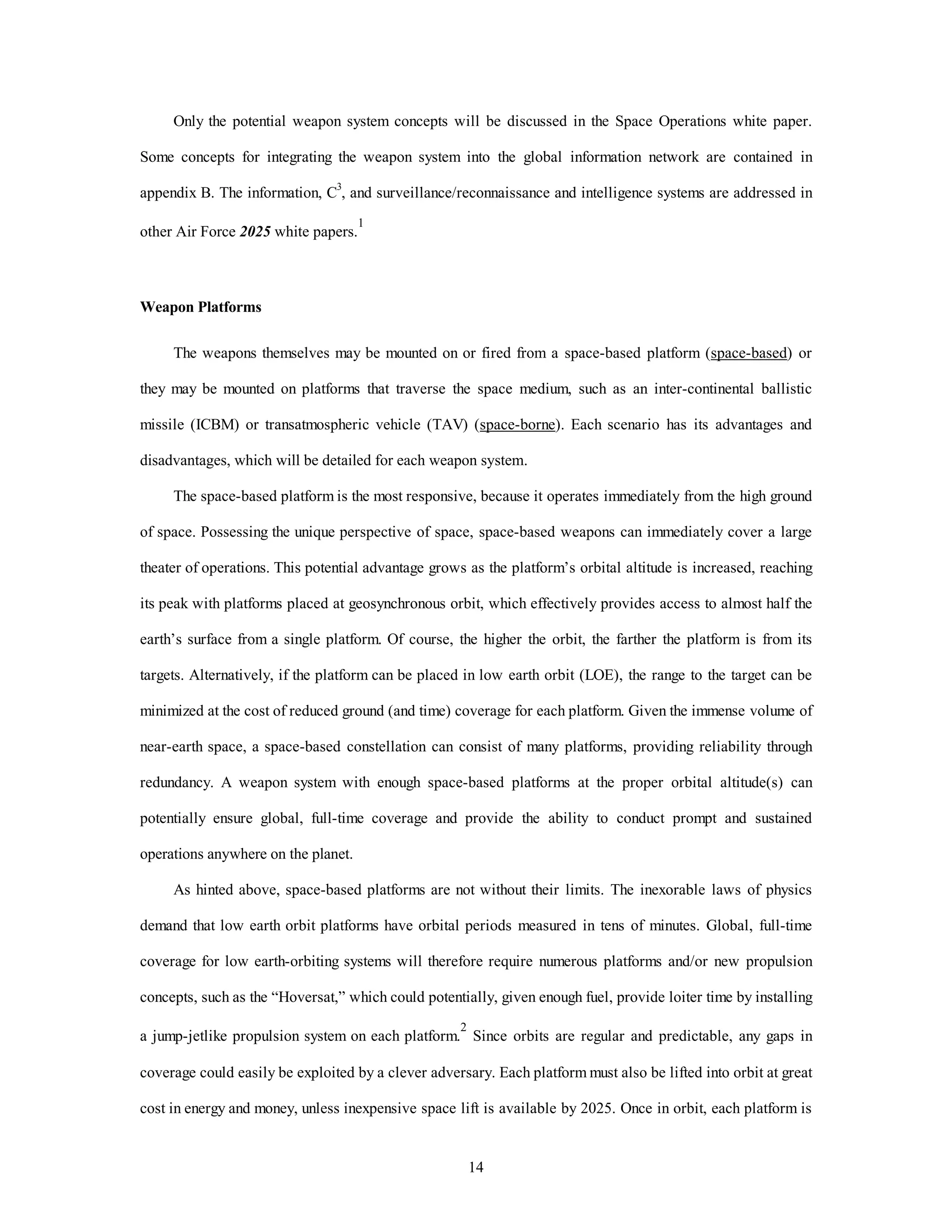
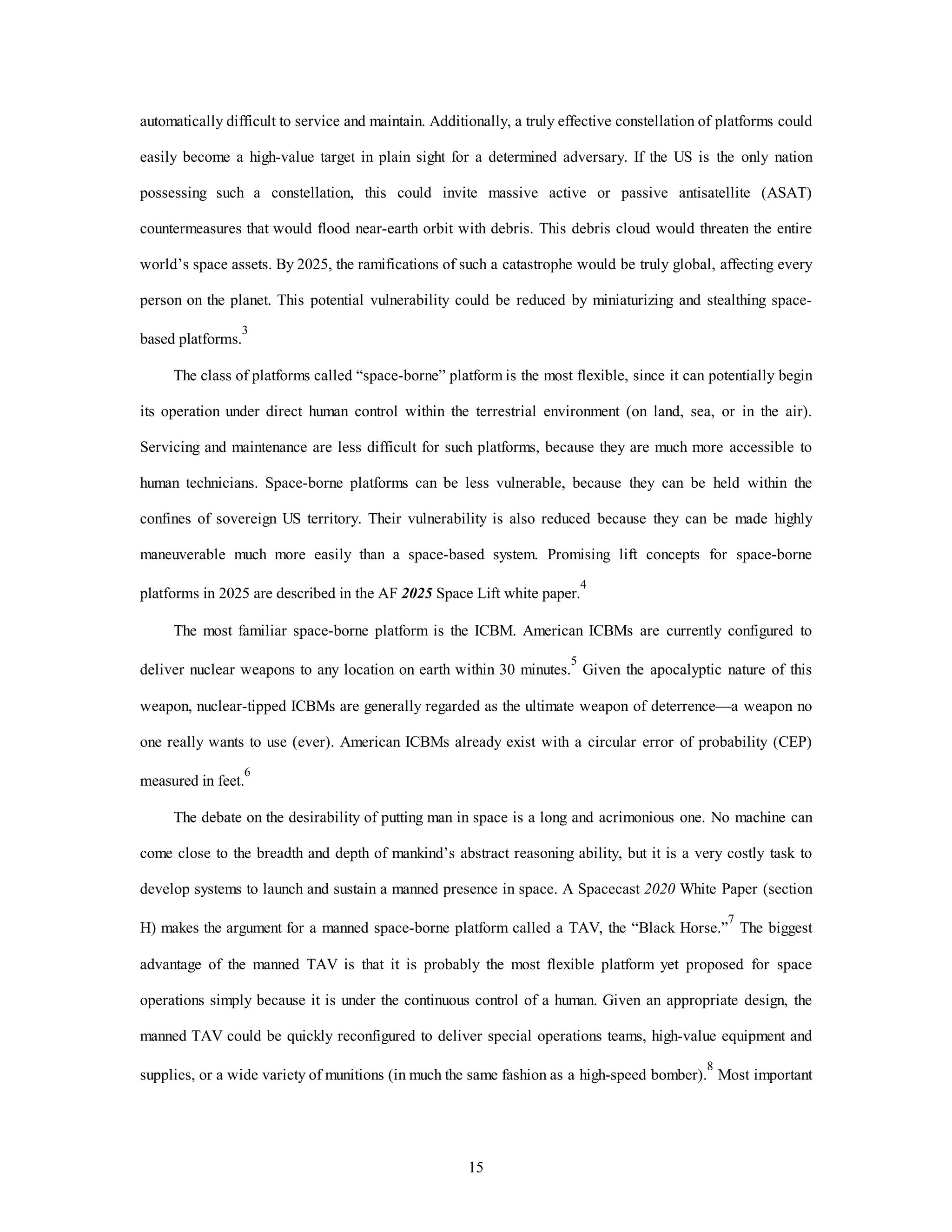
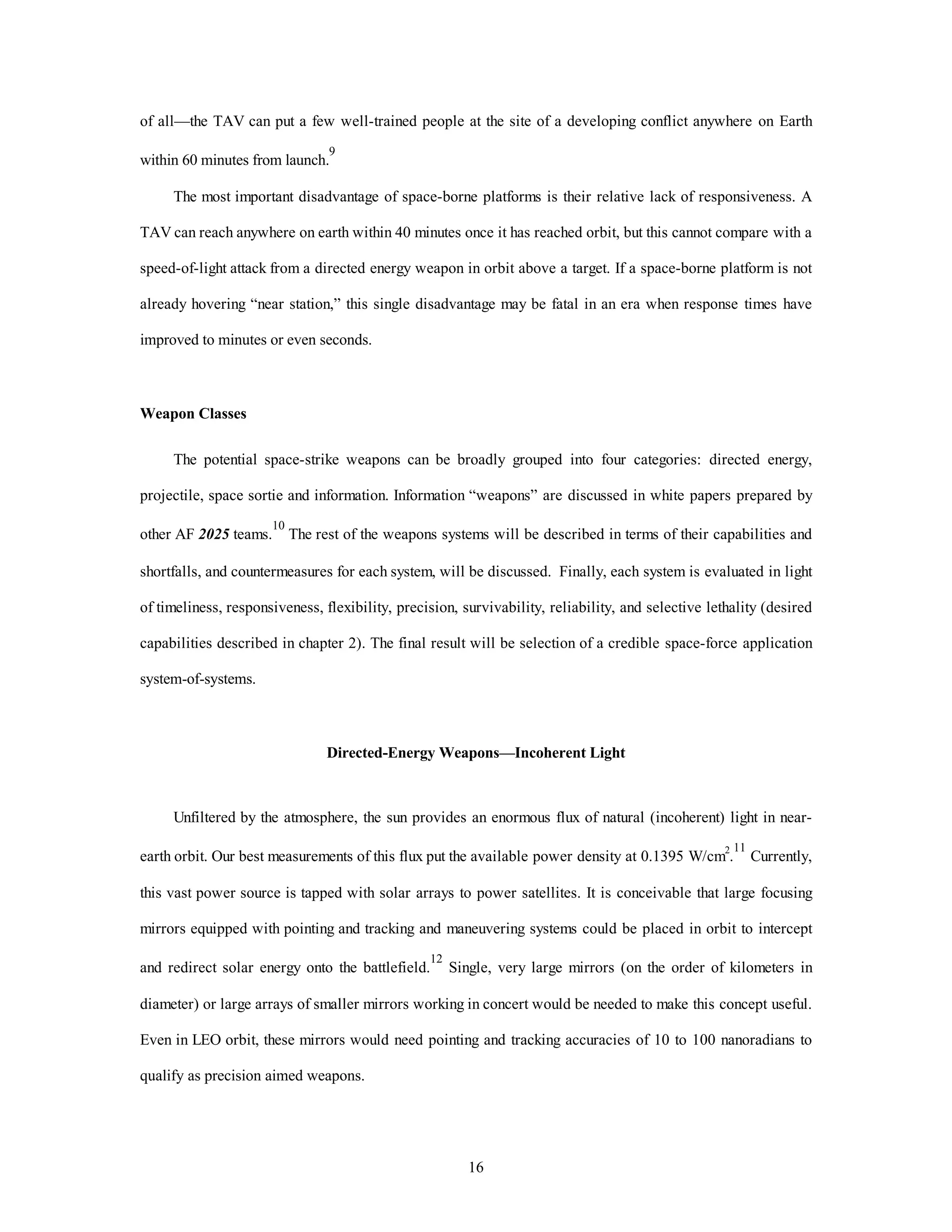

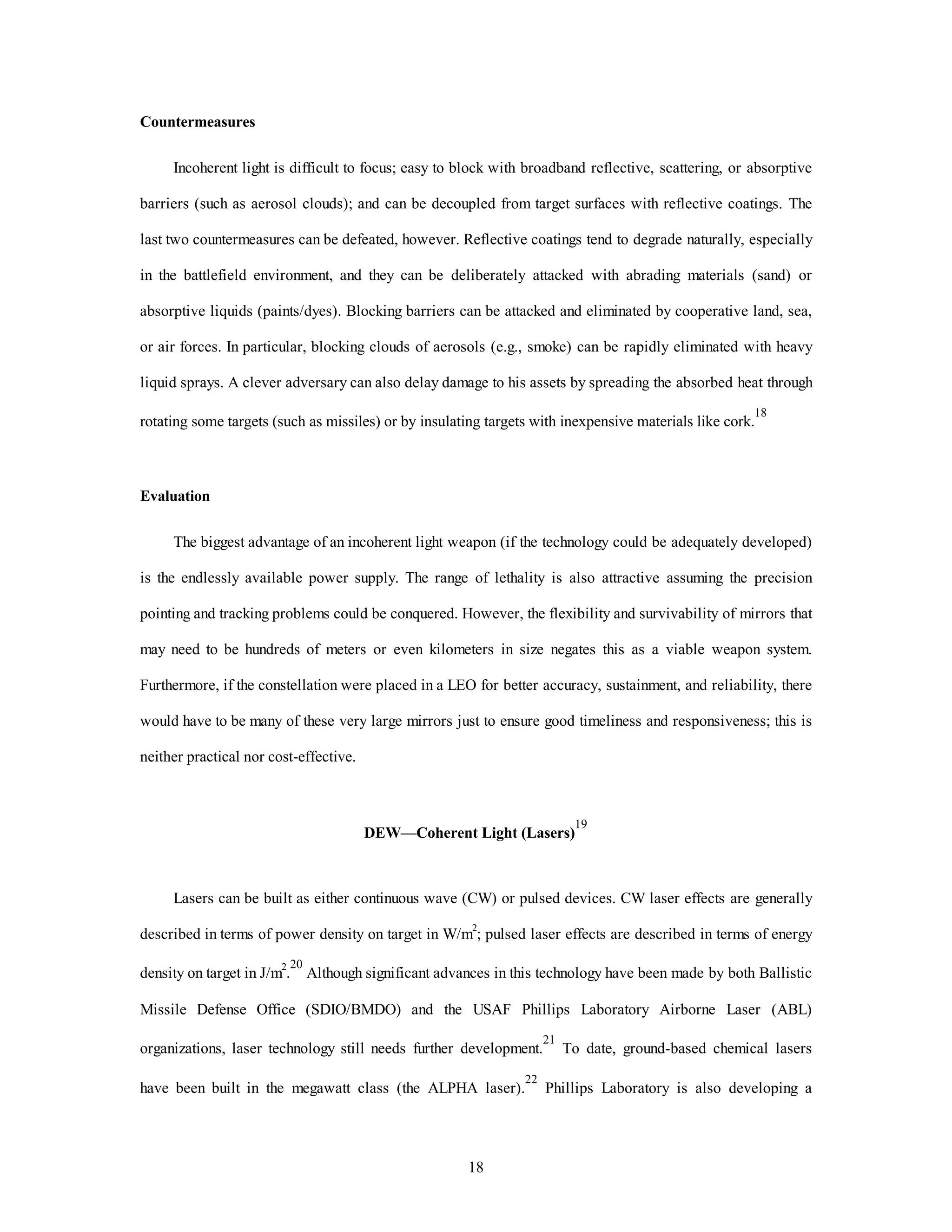





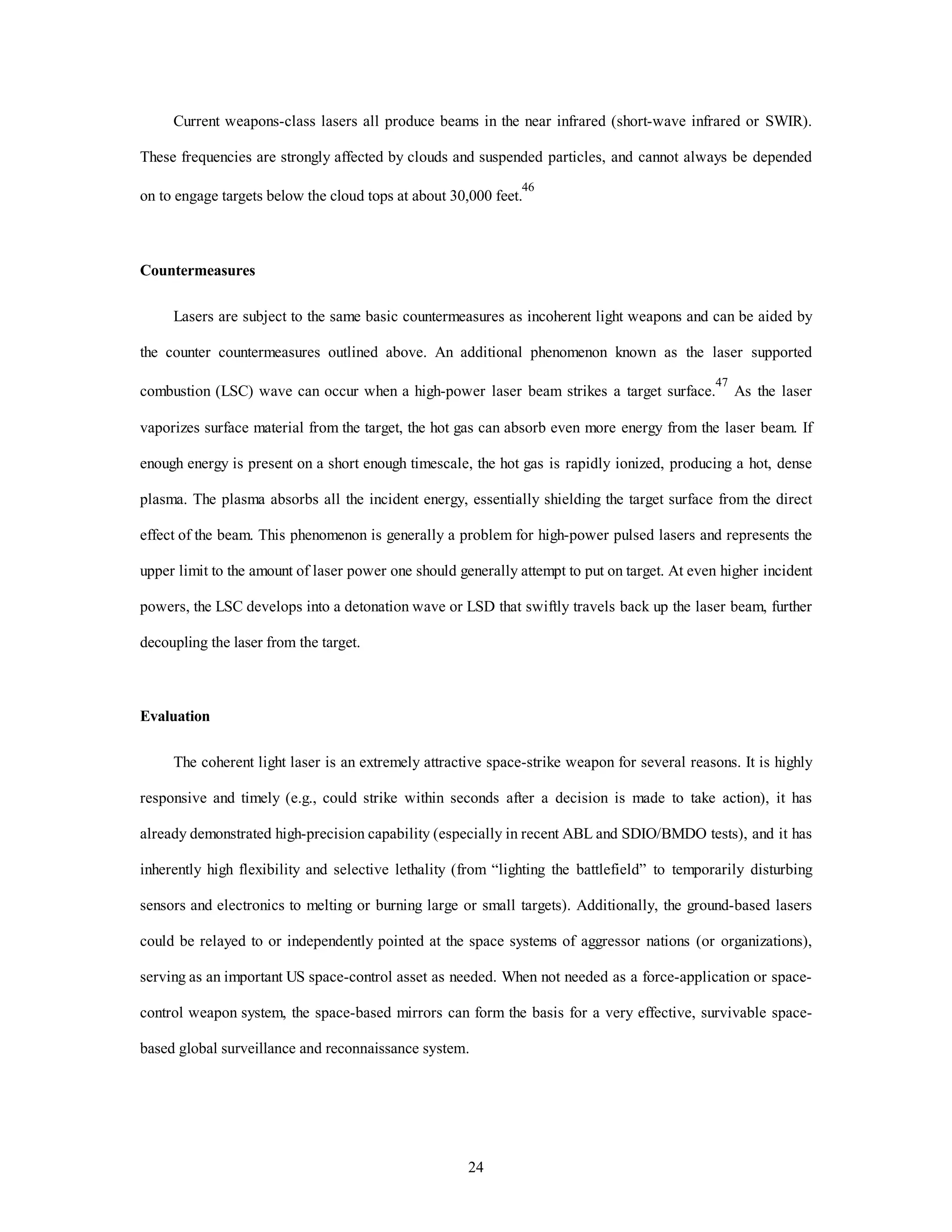


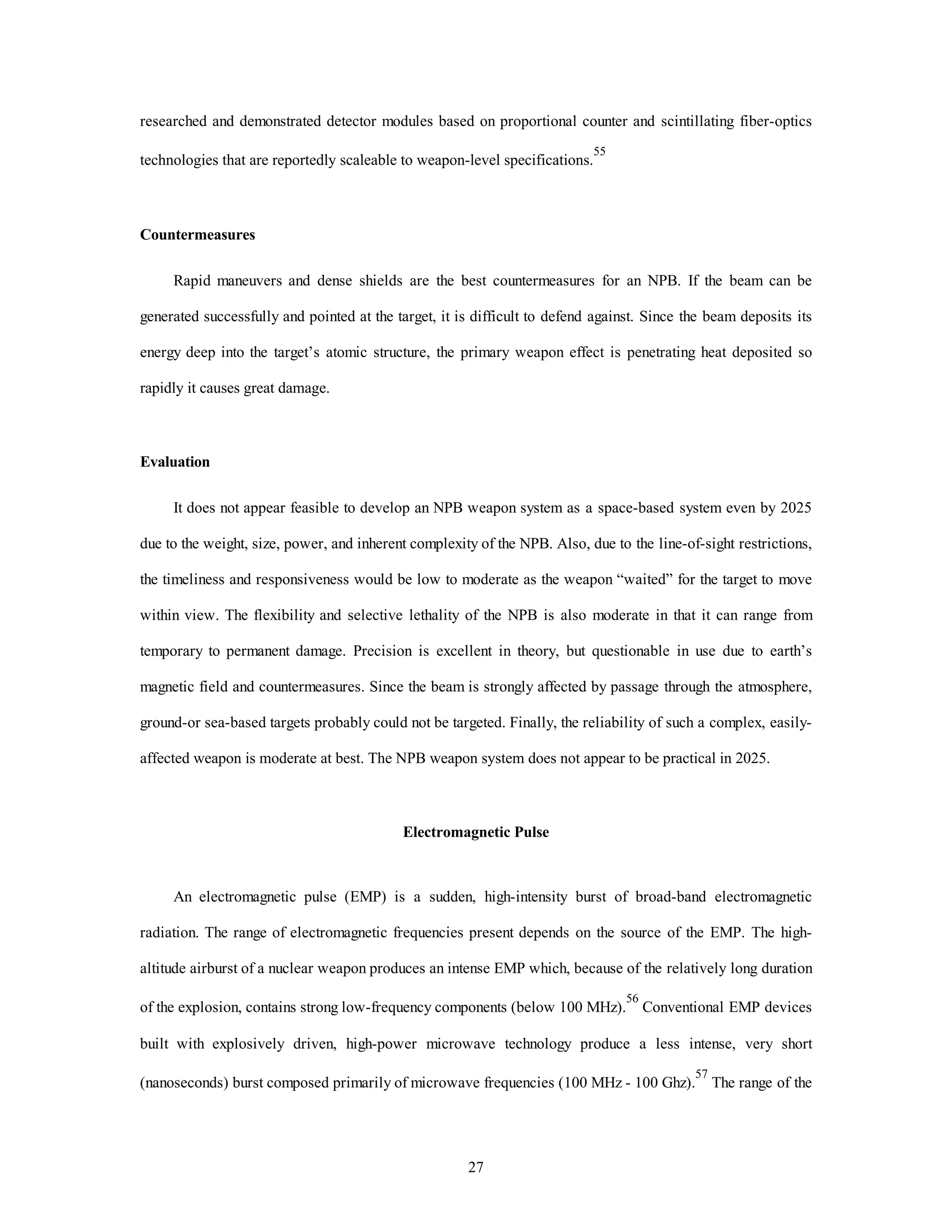
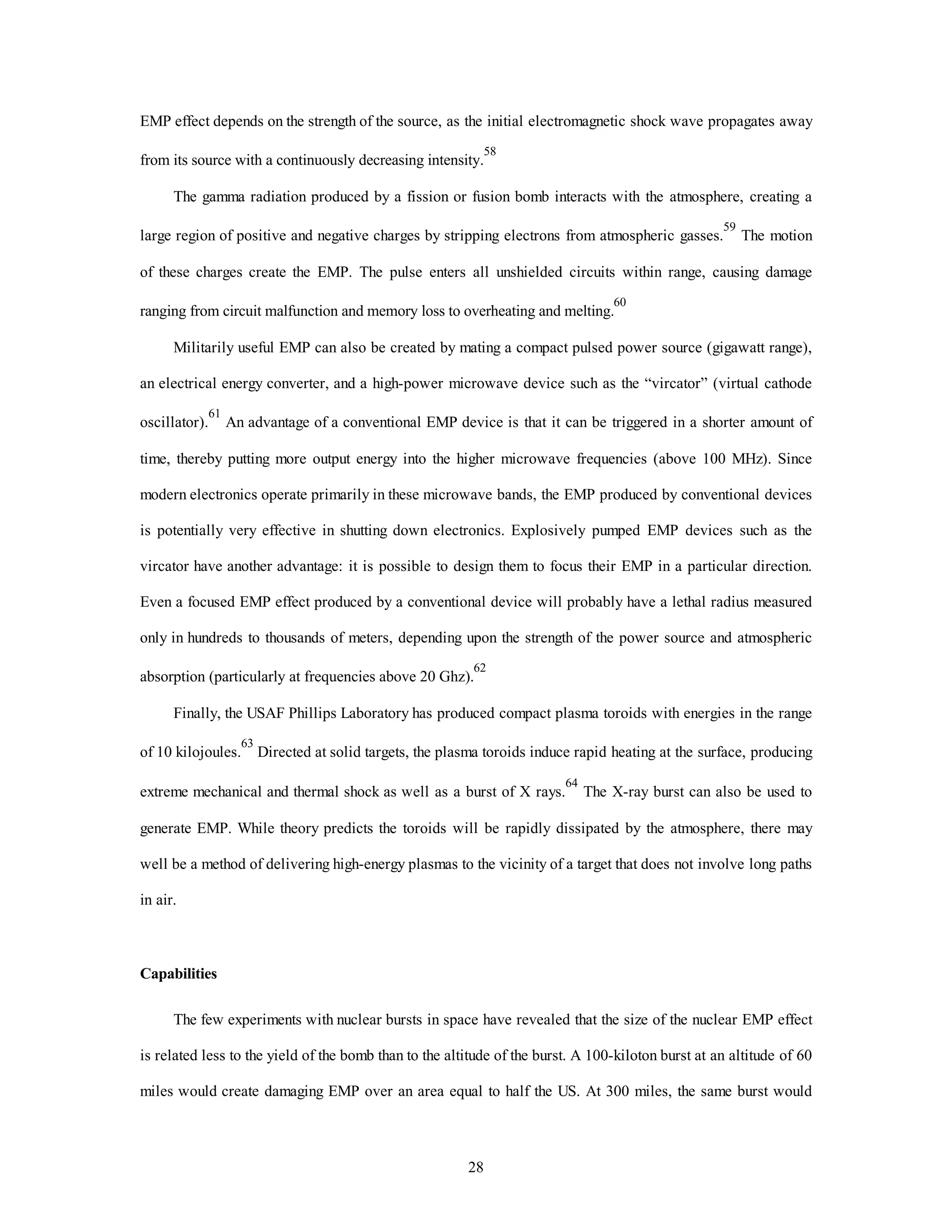
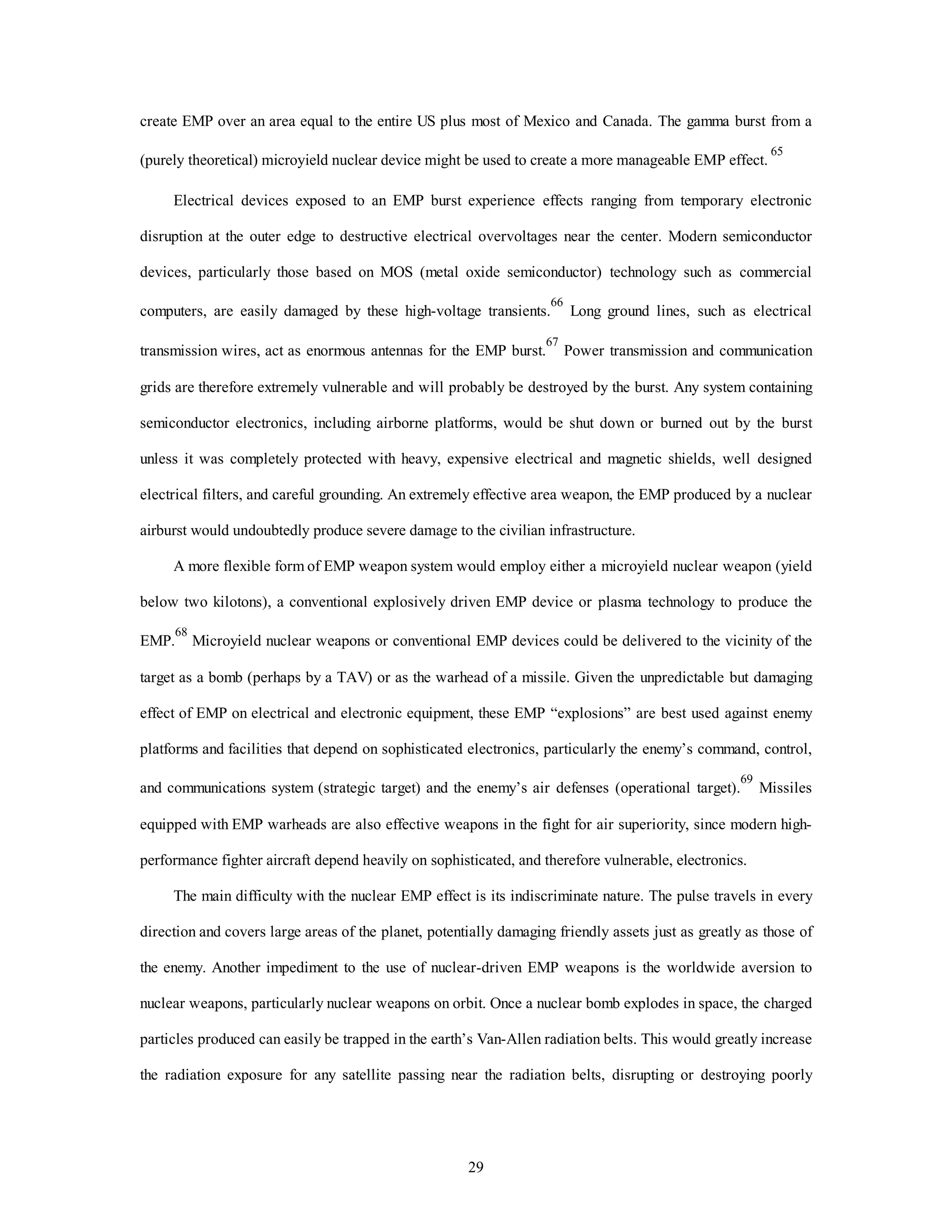
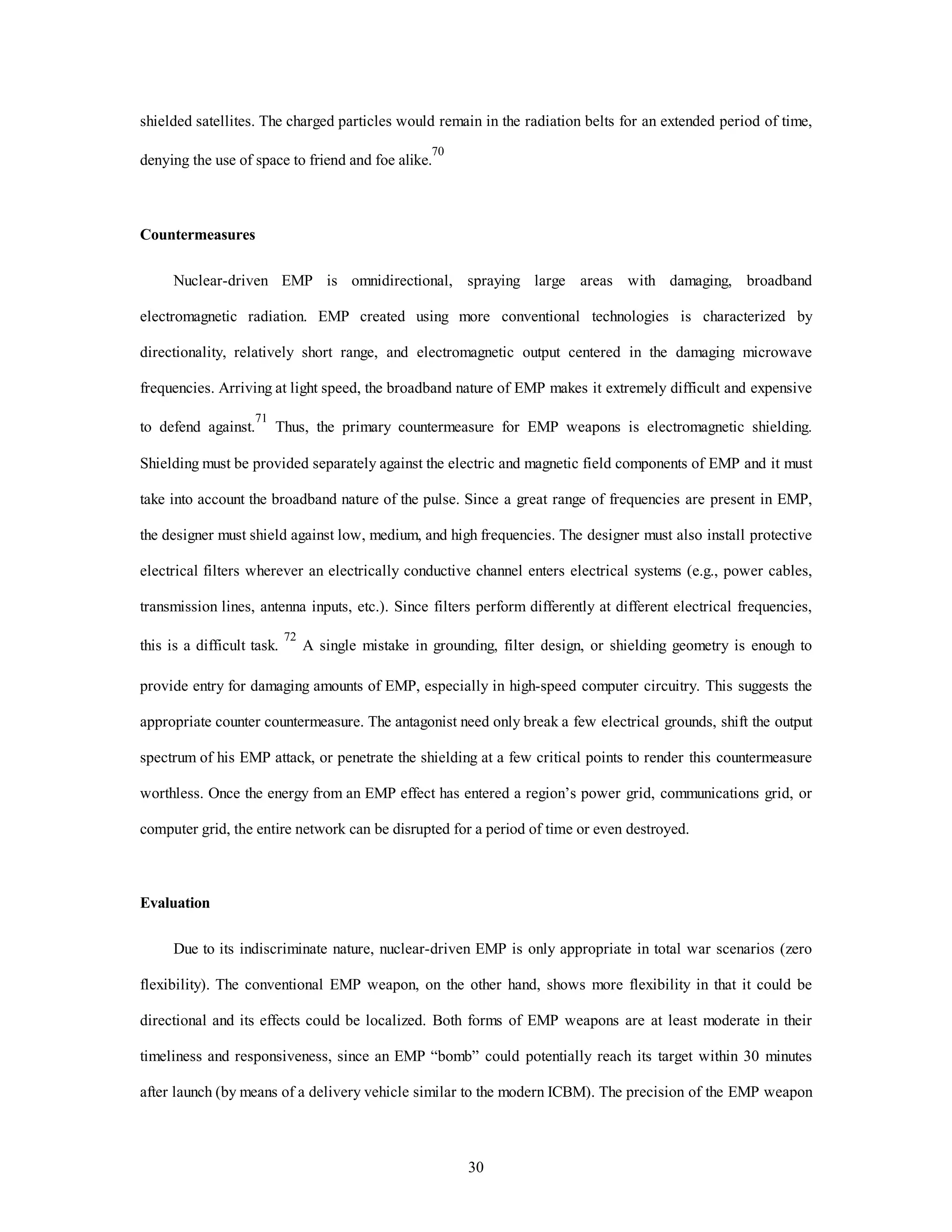
![is relatively low—it is generally useful only for area targets (e.g., enemy towns, large facilities, or a
squadron of enemy aircraft). The survivability and reliability of EMP weapons are moderate to high,
particularly if the weapons themselves are ground based (as the payload of an ICBM or surface launched
ballistic missile [SLBM]). Finally, and most unfortunately, the selective lethality of EMP weapons is low.
The effect of an EMP burst on any given electrical system is highly unpredictable, since it depends in great
detail on the precise geometry of the engagement, the exact design of the electrical system under attack, and
even the current state of the atmosphere. In sum, the conventional EMP weapon has very interesting
possibilities as a potential future weapon. However, the currently unpredictable lethality, limited flexibility,
and questionable precision make it unattractive as the primary component of a space-strike weapon system in
31
2025.
High-Power Microwave
A high-power microwave (HPMW) device also employs electromagnetic radiation as its weapon
effect. Not as powerful as nuclear-driven EMP weapons, HPMW weapons create a narrower band of
microwave electromagnetic radiation by coupling fast, high energy pulsed power supplies to specially
designed microwave antenna arrays. Microwave frequencies (tens of megahertz to tens of gigahertz) are
chosen for two reasons: the atmosphere is generally transparent to microwave radiation (all-weather
capability) and modern electronics are particularly vulnerable to these frequencies. Unlike most EMP
weapons, HPMW weapons produce beams defined by the shape and character of their microwave antenna
array. HPMW beams are broader than those produced by NPBs and lasers, and this space-strike weapon
system does not require extreme pointing and tracking accuracies (100 nanoradian stability and one meter
target accuracy are adequate). HPMW weapons can be trained on a target for an extended period of time,
provided the power supply and HPMW circuitry can withstand the internal currents. As a rough point of
comparison, HPMW systems produce 100 - 1,000 times the output power of modern electronic warfare (EW)
systems.73](https://image.slidesharecdn.com/vol3ch14-140914105123-phpapp02/75/Vol3ch14-39-2048.jpg)
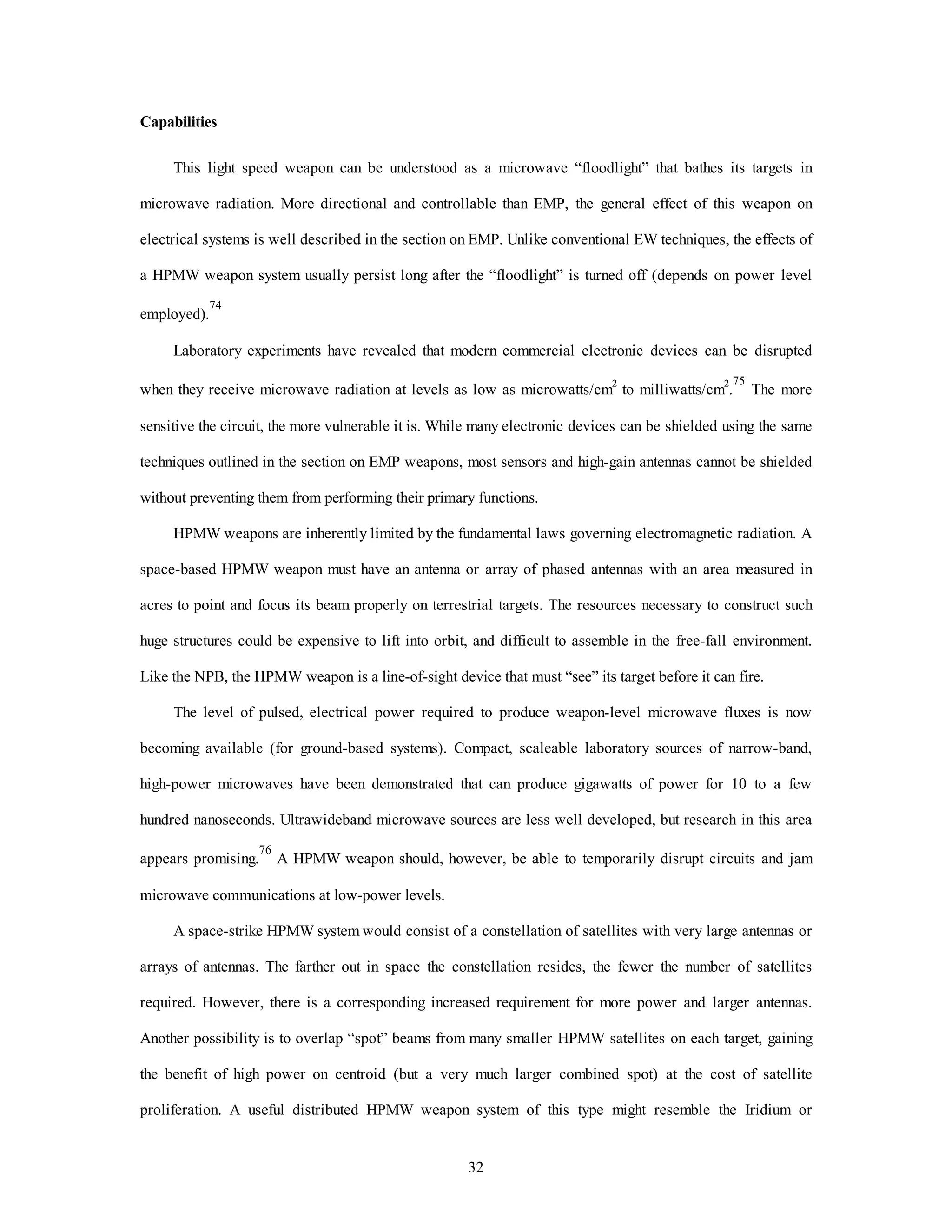

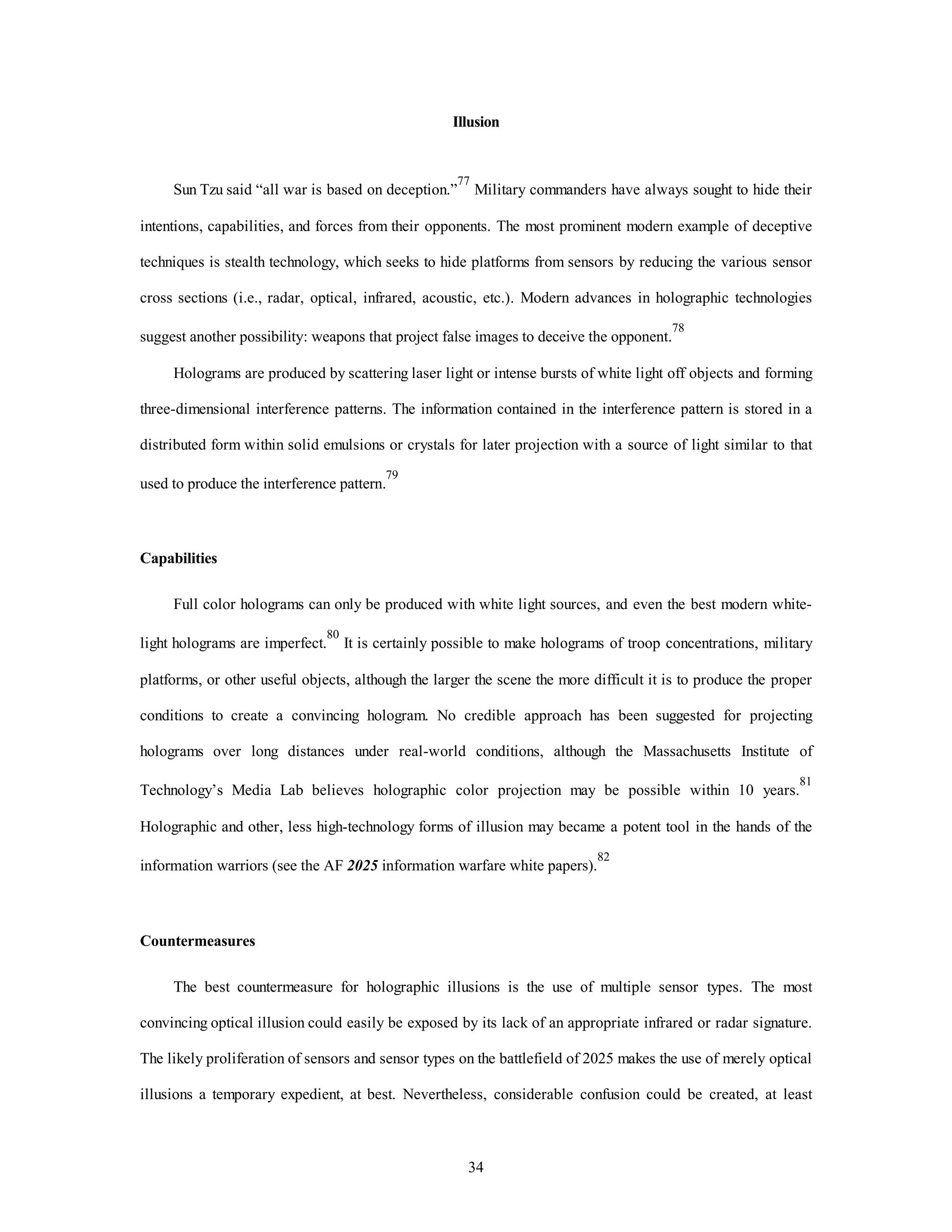

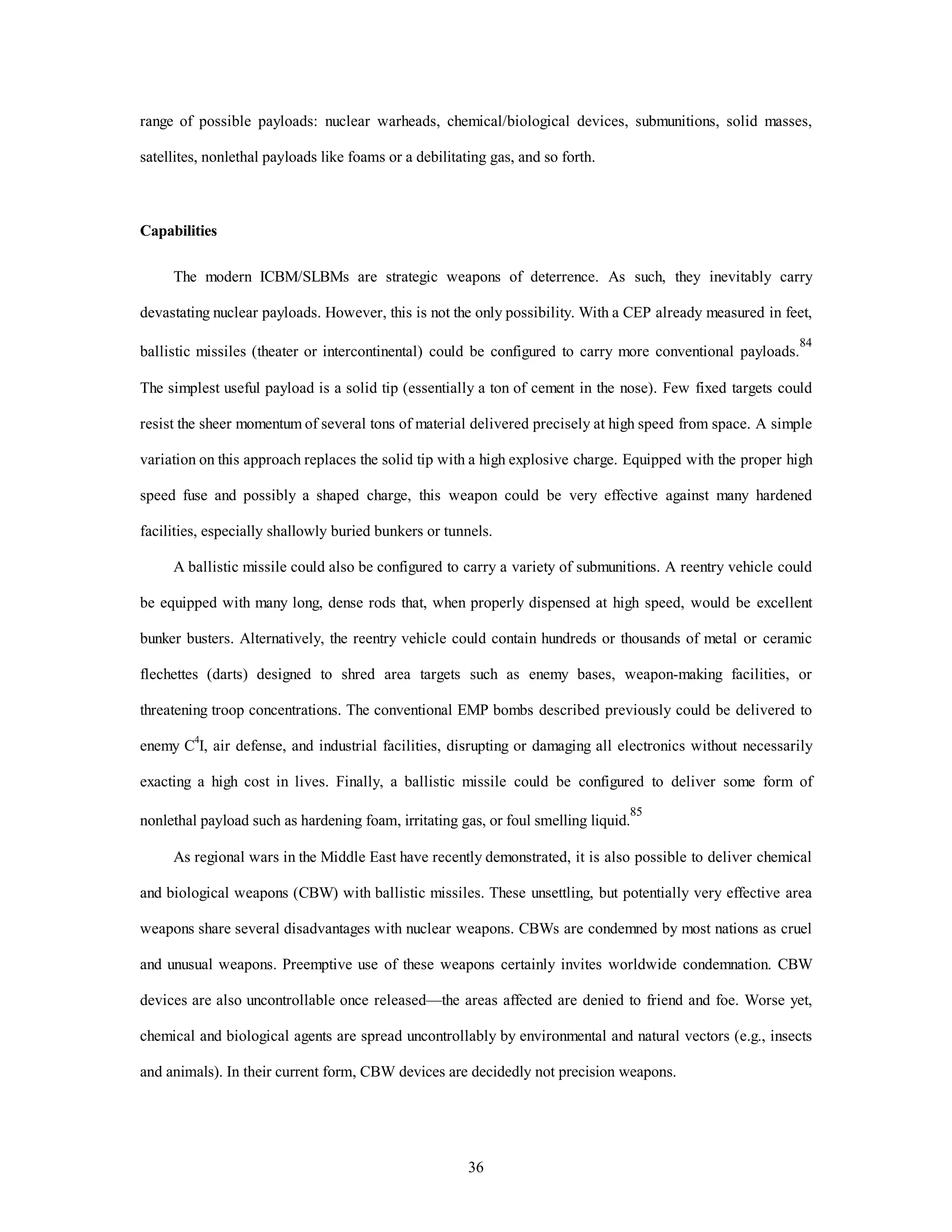
![37
Countermeasures
Ballistic missiles, whether theater or strategic in nature, are a particularly high-value target for space-strike
laser weapon systems. Ballistic missiles spend tens to hundreds of seconds in the boost phase (theater
ballistic missile [TBM] versus ICBM) followed by tens of seconds to tens of minutes in the postboost
phase.86 These missiles are easily detected by their plumes only during boost phase, the shortest phase of
their trajectory. During this brief interval of vulnerability, a light-speed kill by a space-based or space-borne
laser weapon system can settle the problem before it has the opportunity to deploy MIRVs (multiple
independently targeted reentry vehicles). In general, ballistic missile countermeasures have been addressed
in great detail by the Ballistic Missile Defense Organization. The solutions range from direct interception by
high-speed rockets and missiles to airborne and ground based-high energy laser strikes.87
The appropriate countercountermeasures are obvious. Stealthy reentry vehicles could be built that elude
ground- and space-based sensors, although the designer would be forced to address optical, infrared, and
multifrequency radar problems simultaneously. Alternatively, very small, very agile reentry vehicles that
greatly complicate the problem of terminal defense could be designed.
Evaluation
Most of these missile-delivered weapons could be built today. All of the essential technologies,
including precise delivery, are already available. The flexibility of the/a ballistic missile system is moderate,
precision good, survivability may be tenuous in 2025, reliability is good, and selective lethality is limited
with this system. Because of these limits on selective lethality and potential survivability problems, the
ballistic missile will probably not be suitable for space force application in 2025.
Projectile Weapons—Kinetic Energy
This type of projectile weapon is closely related to the solid-tipped ballistic missile. Kinetic-energy
weapons come in two classes related to their velocity—the Kinetic Energy Penetrator (KEP) and the
Hydrodynamic Penetrator (HP).88 The KEP has a maximum impact velocity of 3 kilofeet per second (kfps),](https://image.slidesharecdn.com/vol3ch14-140914105123-phpapp02/75/Vol3ch14-45-2048.jpg)

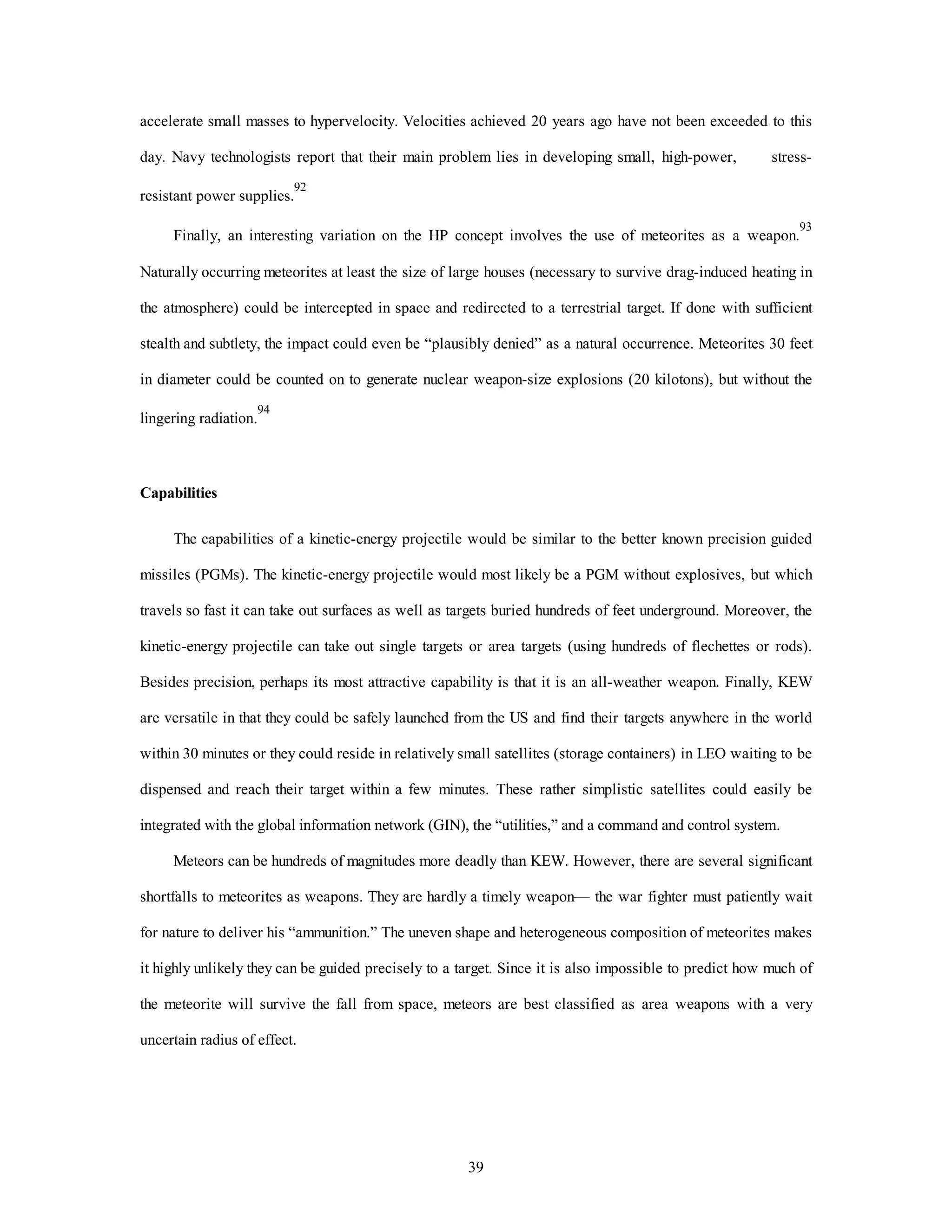
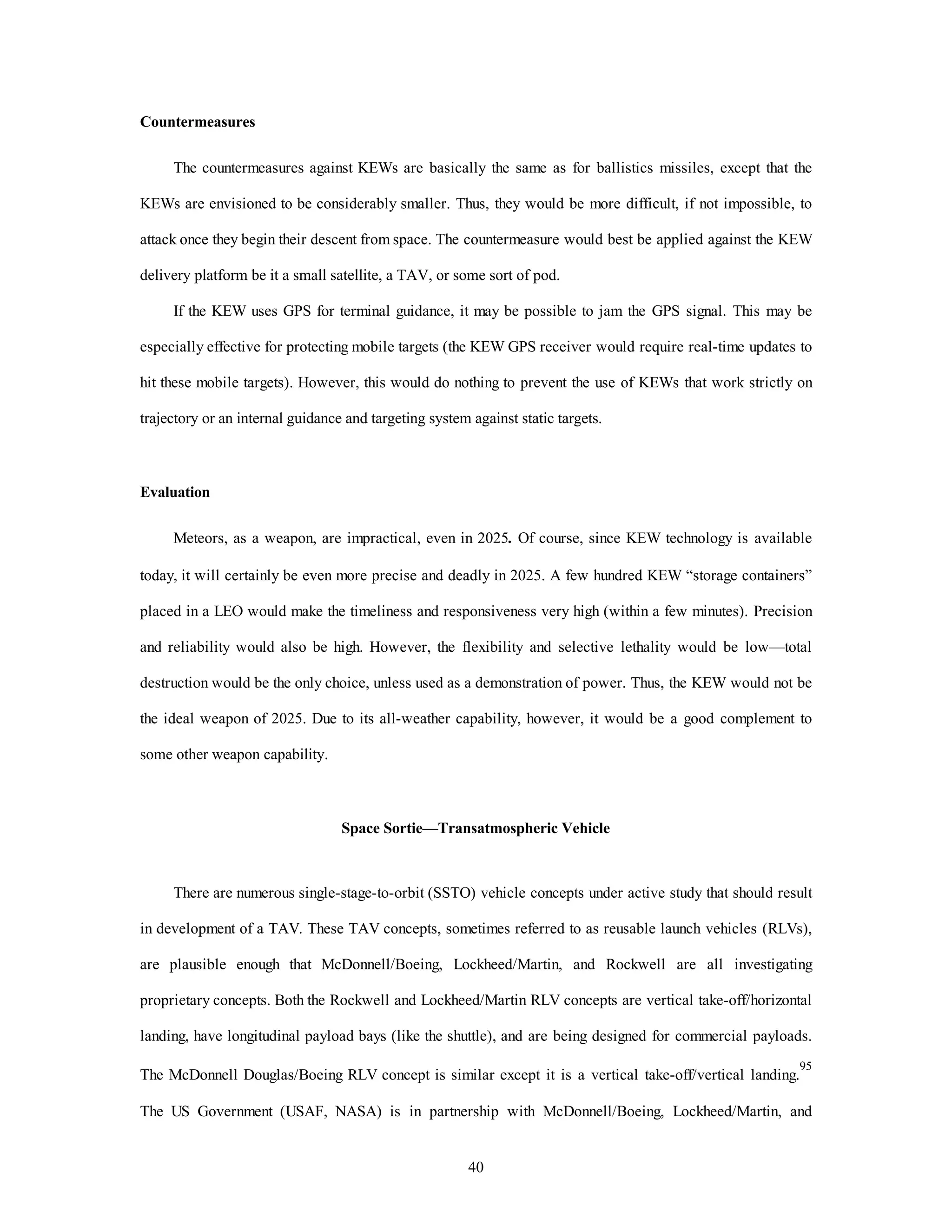
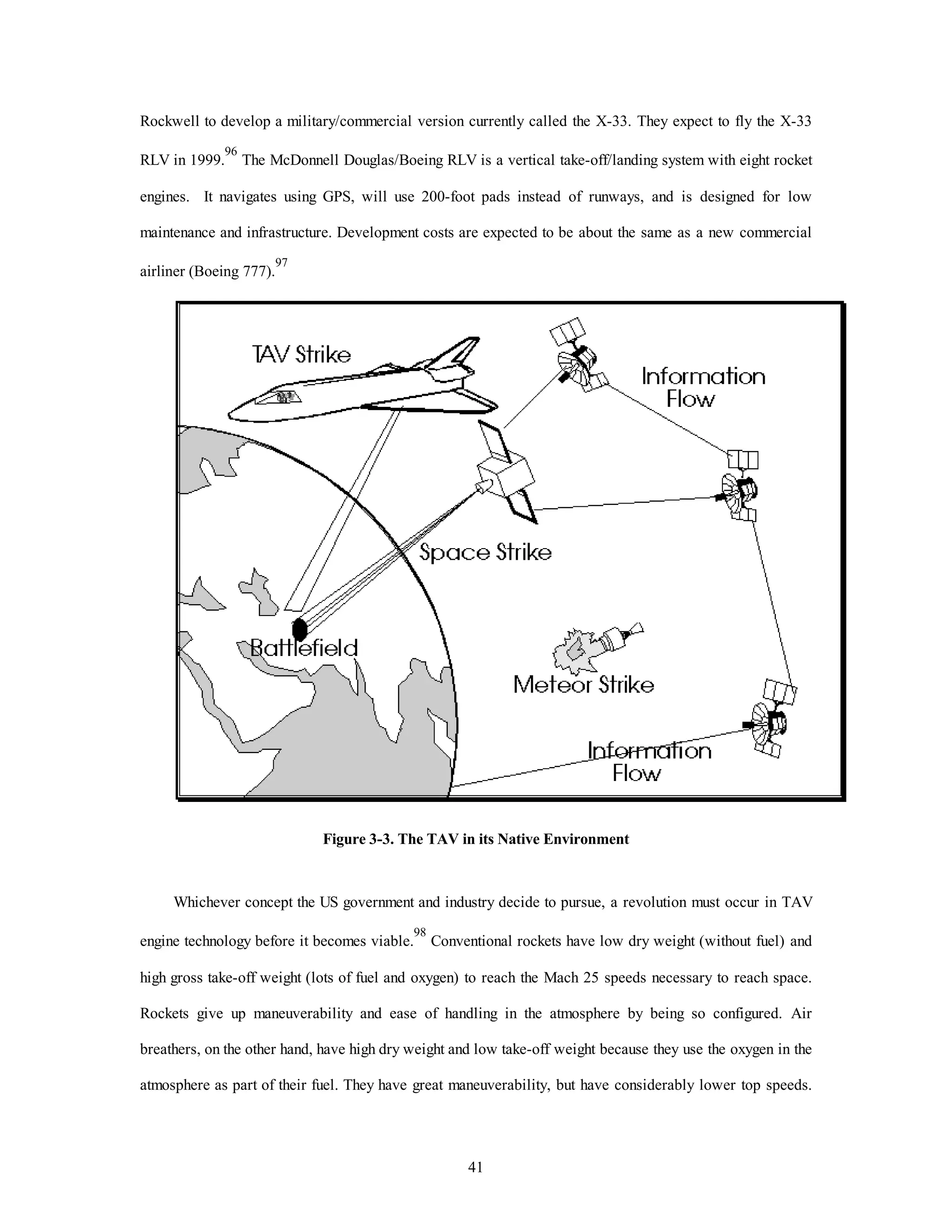

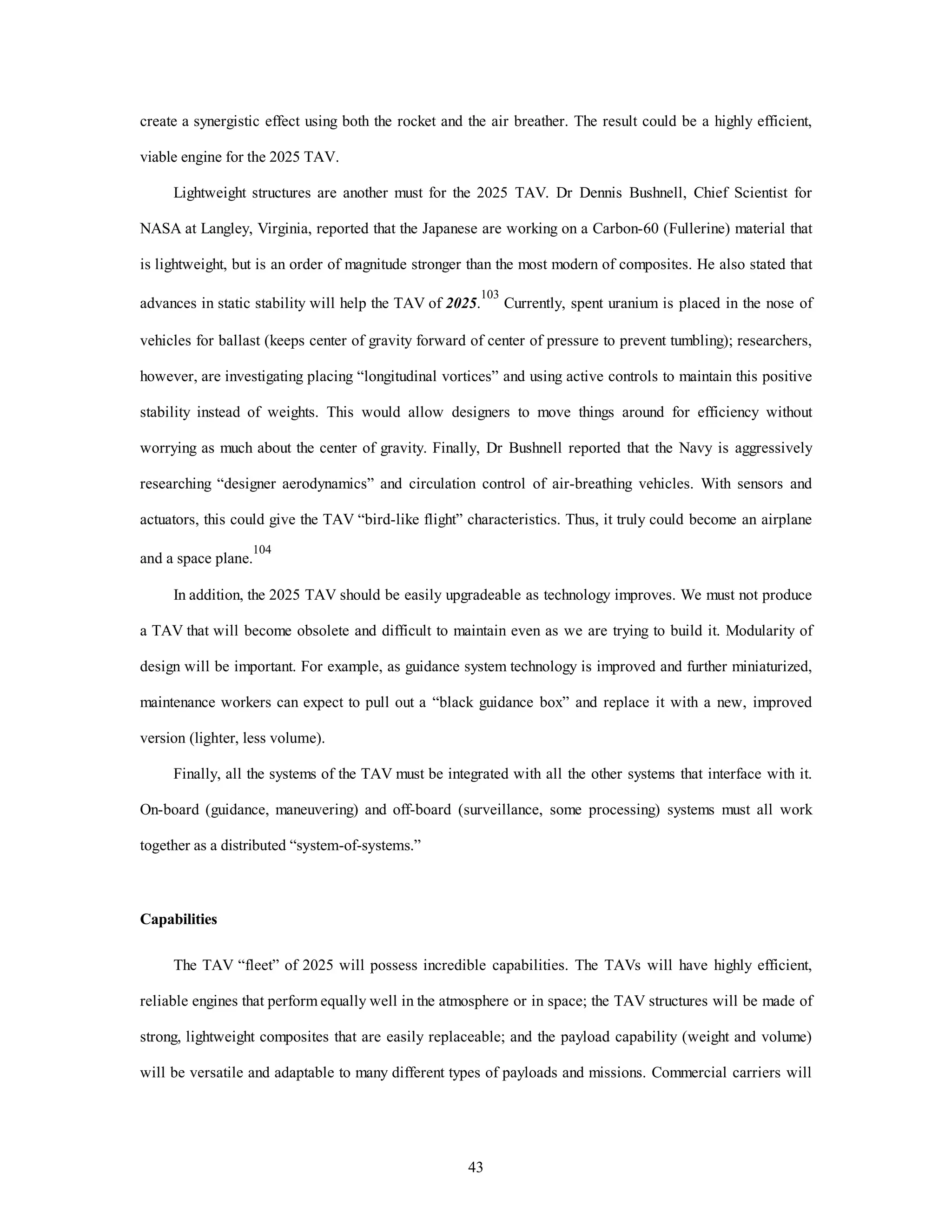

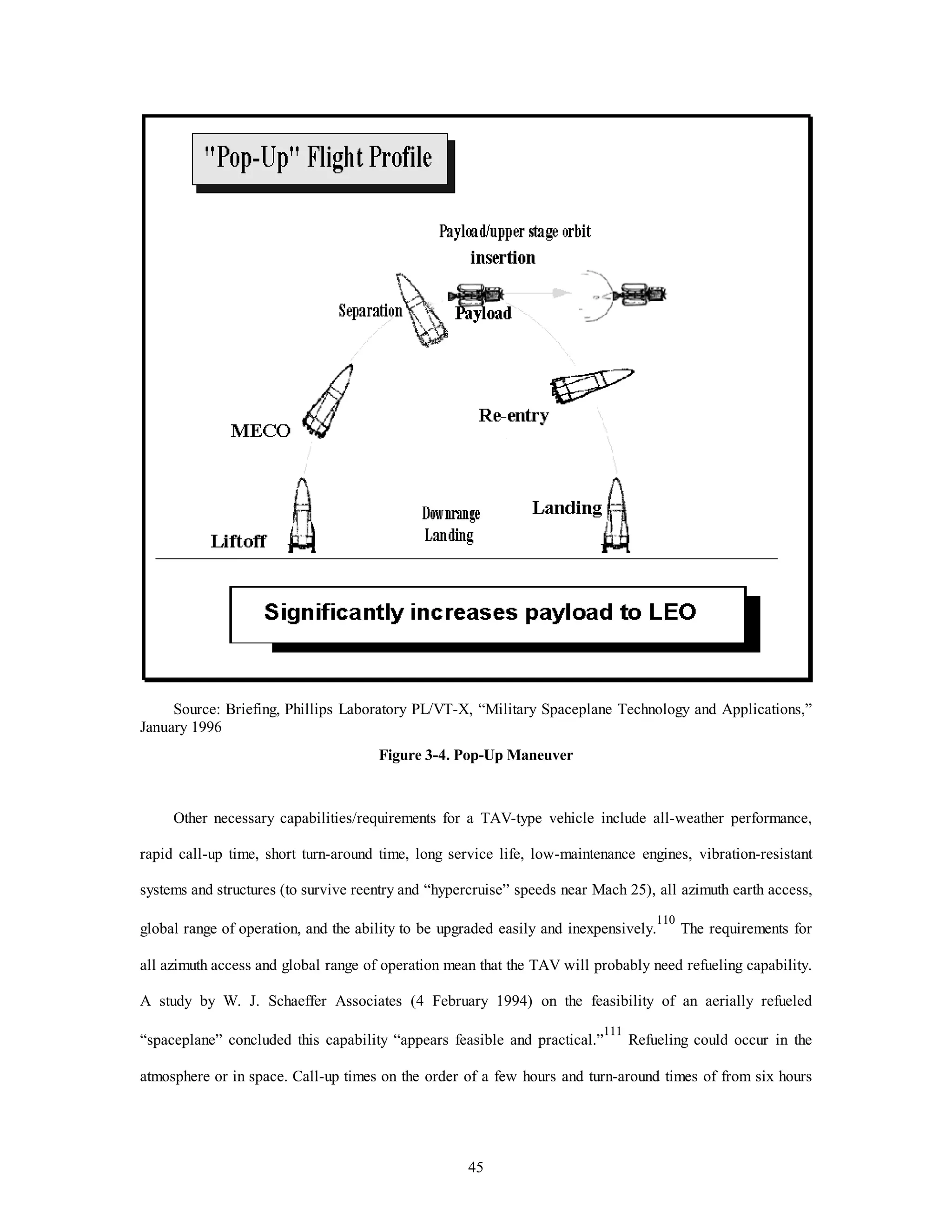

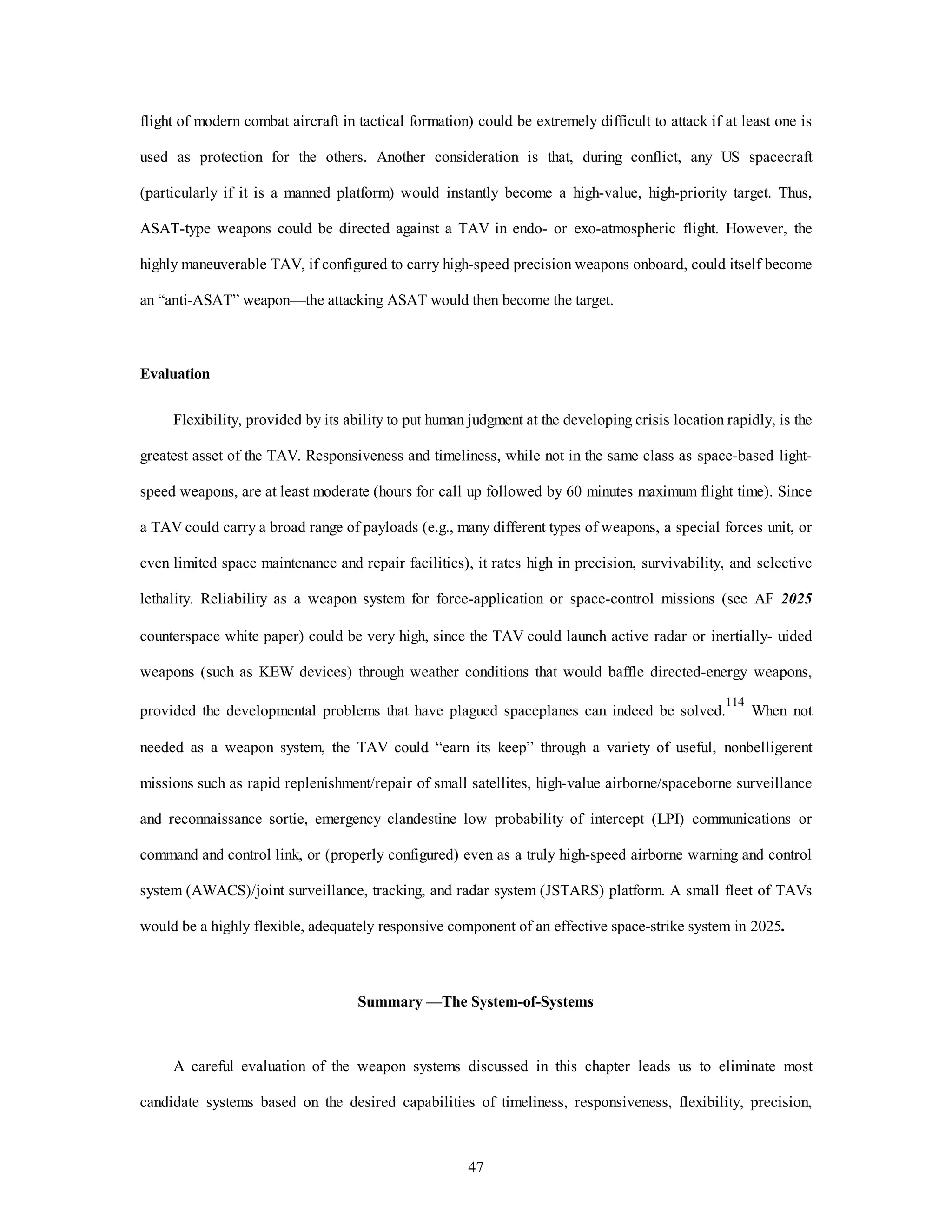


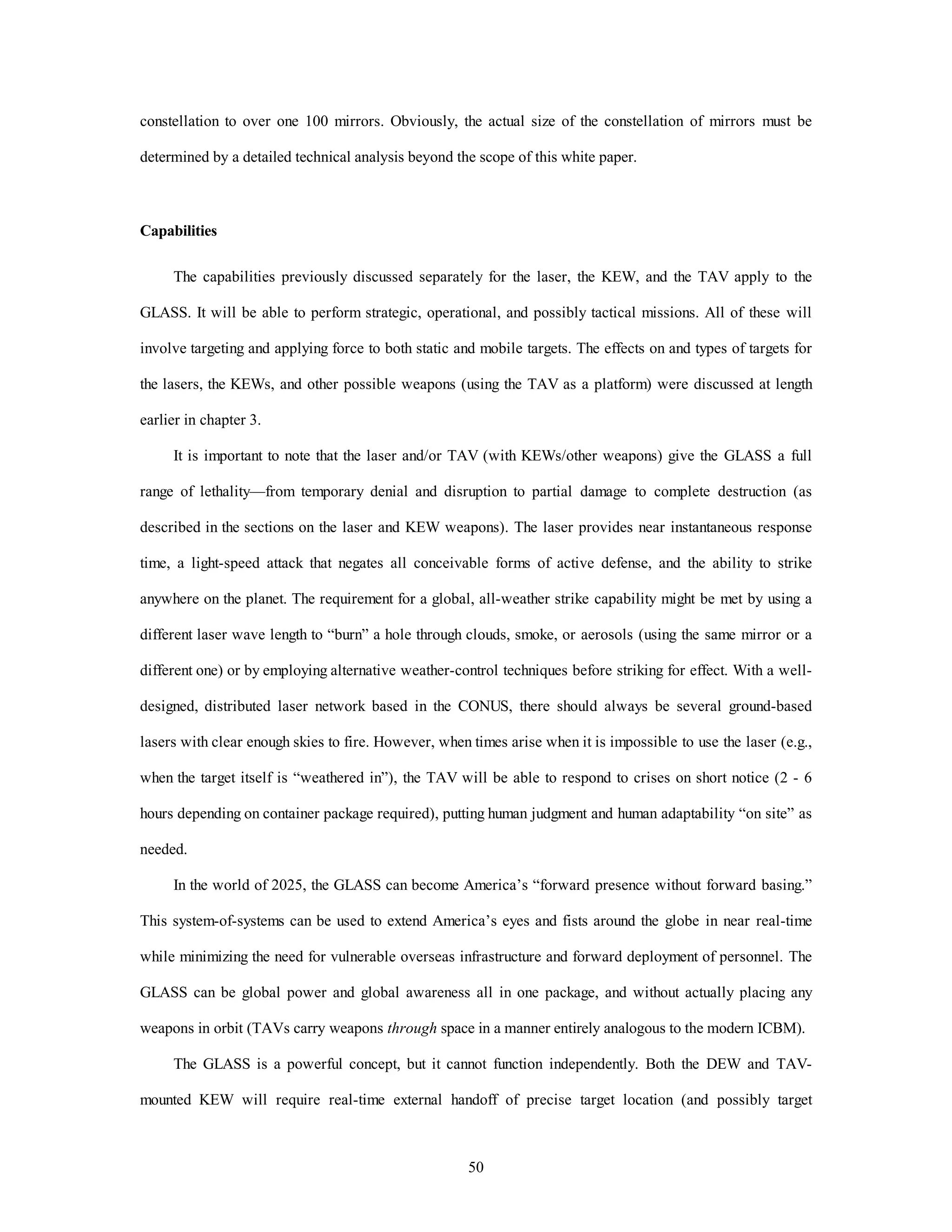


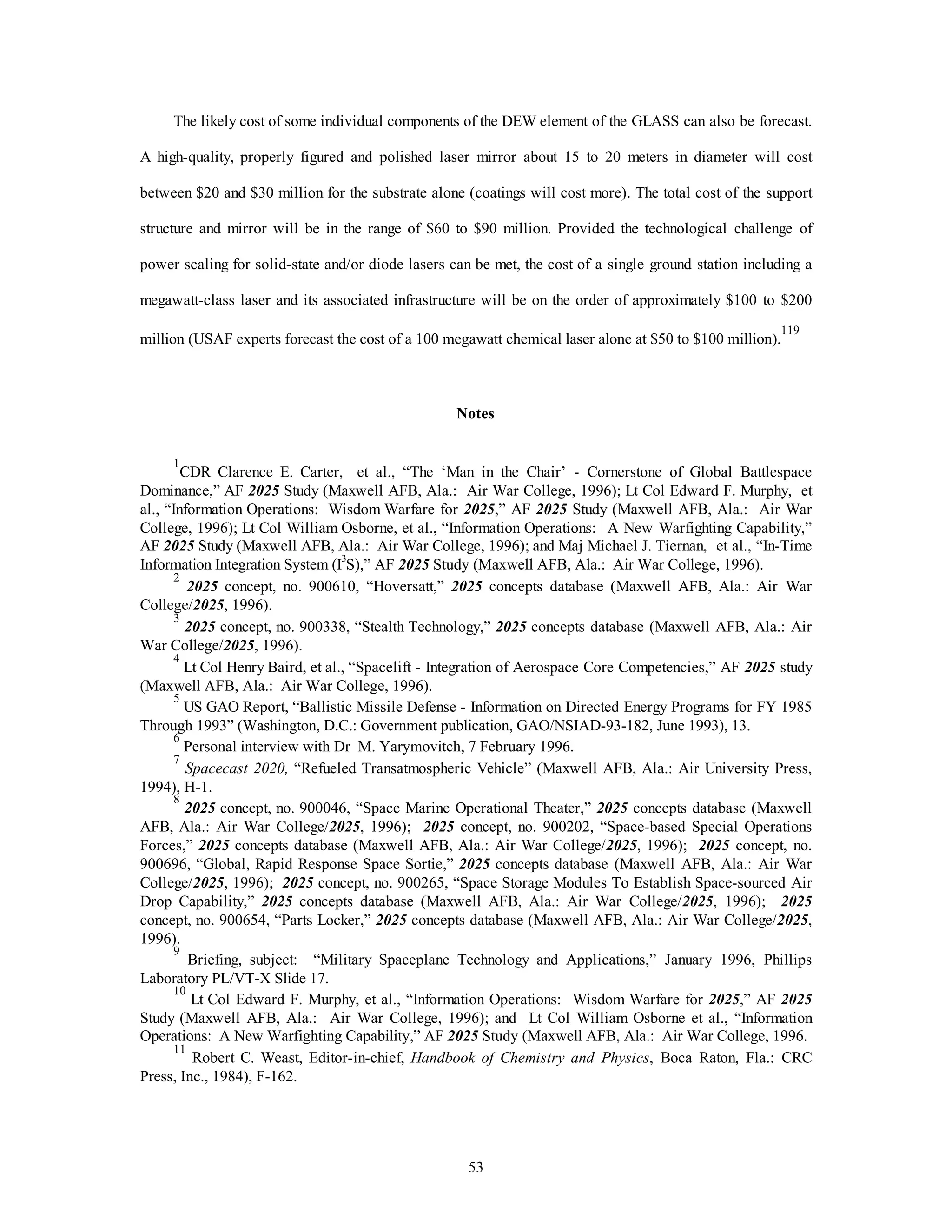
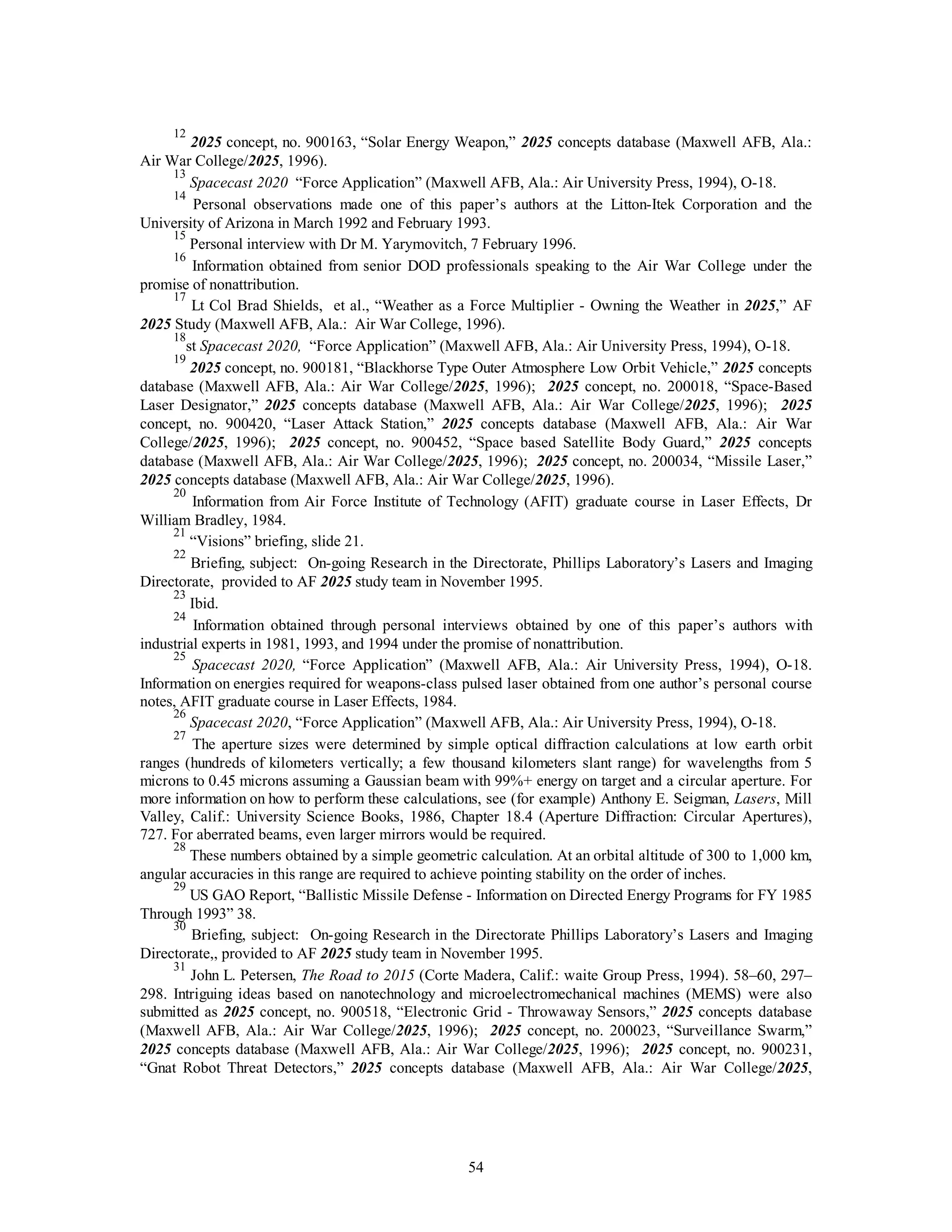

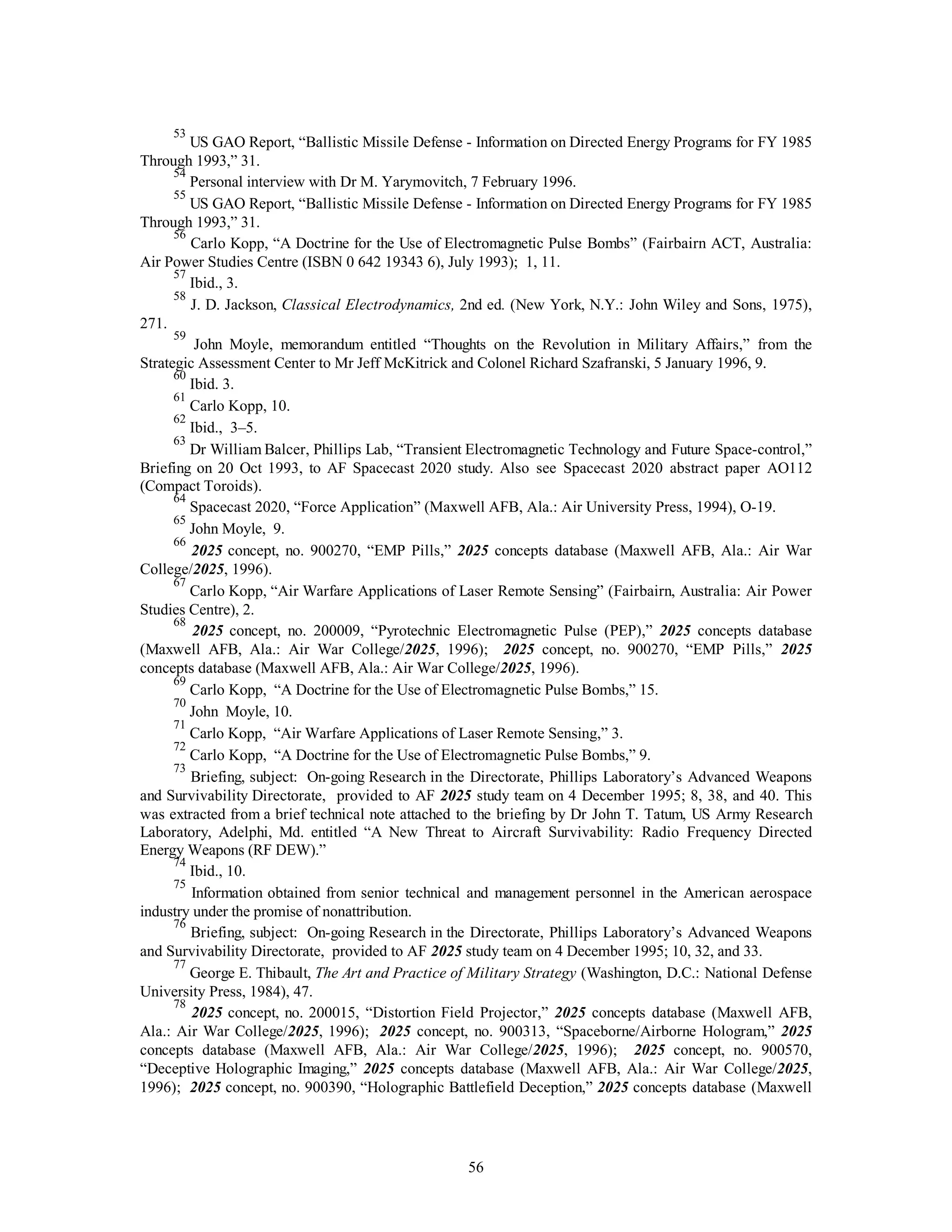

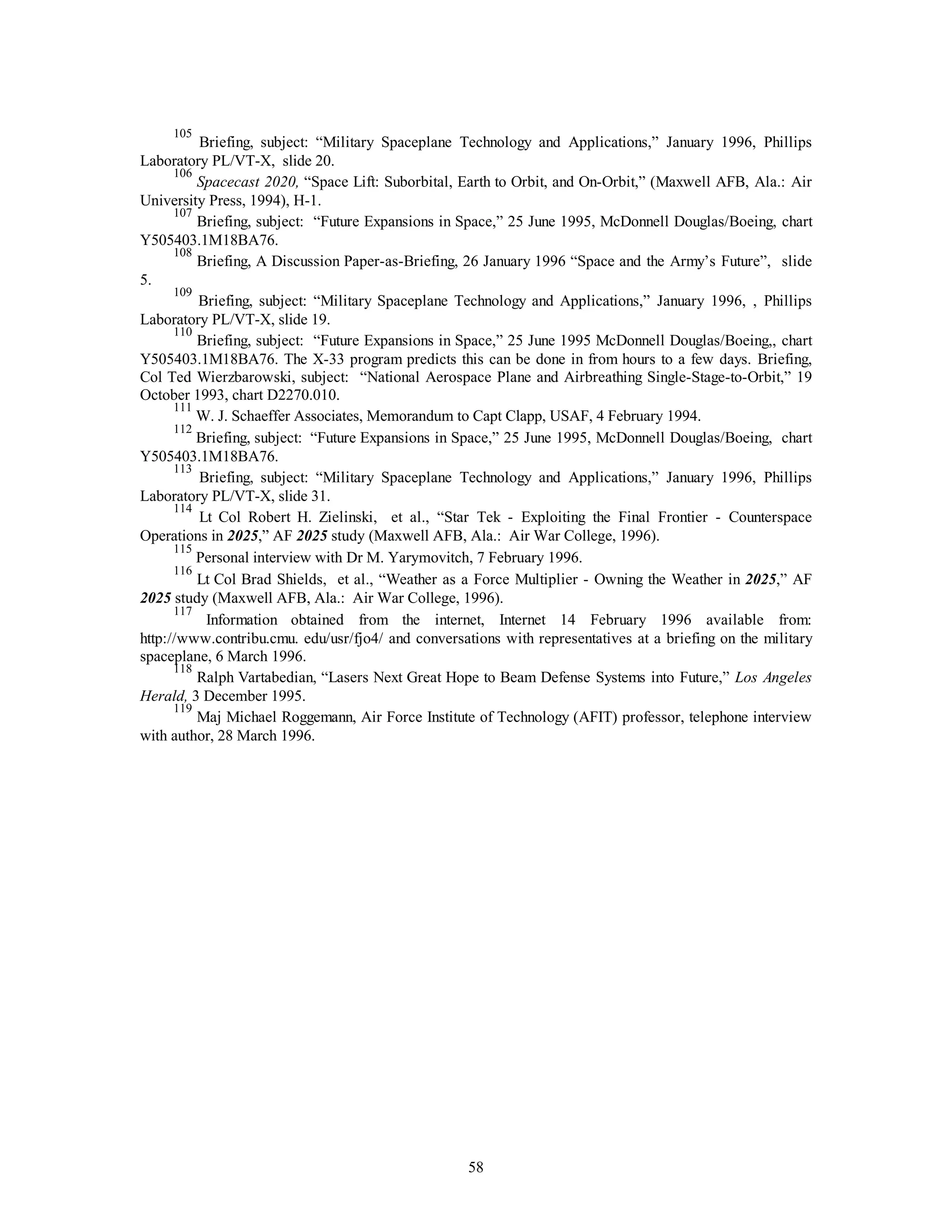
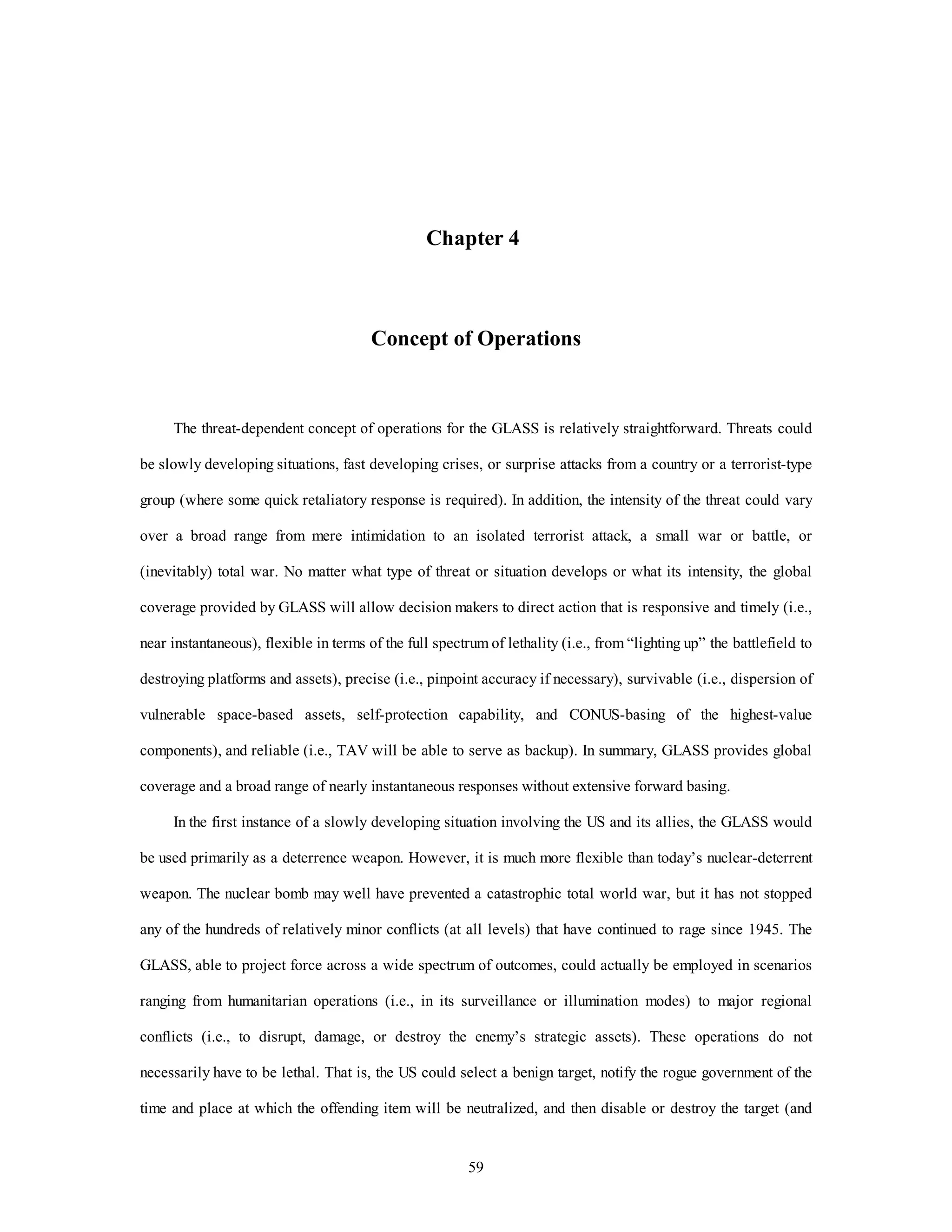

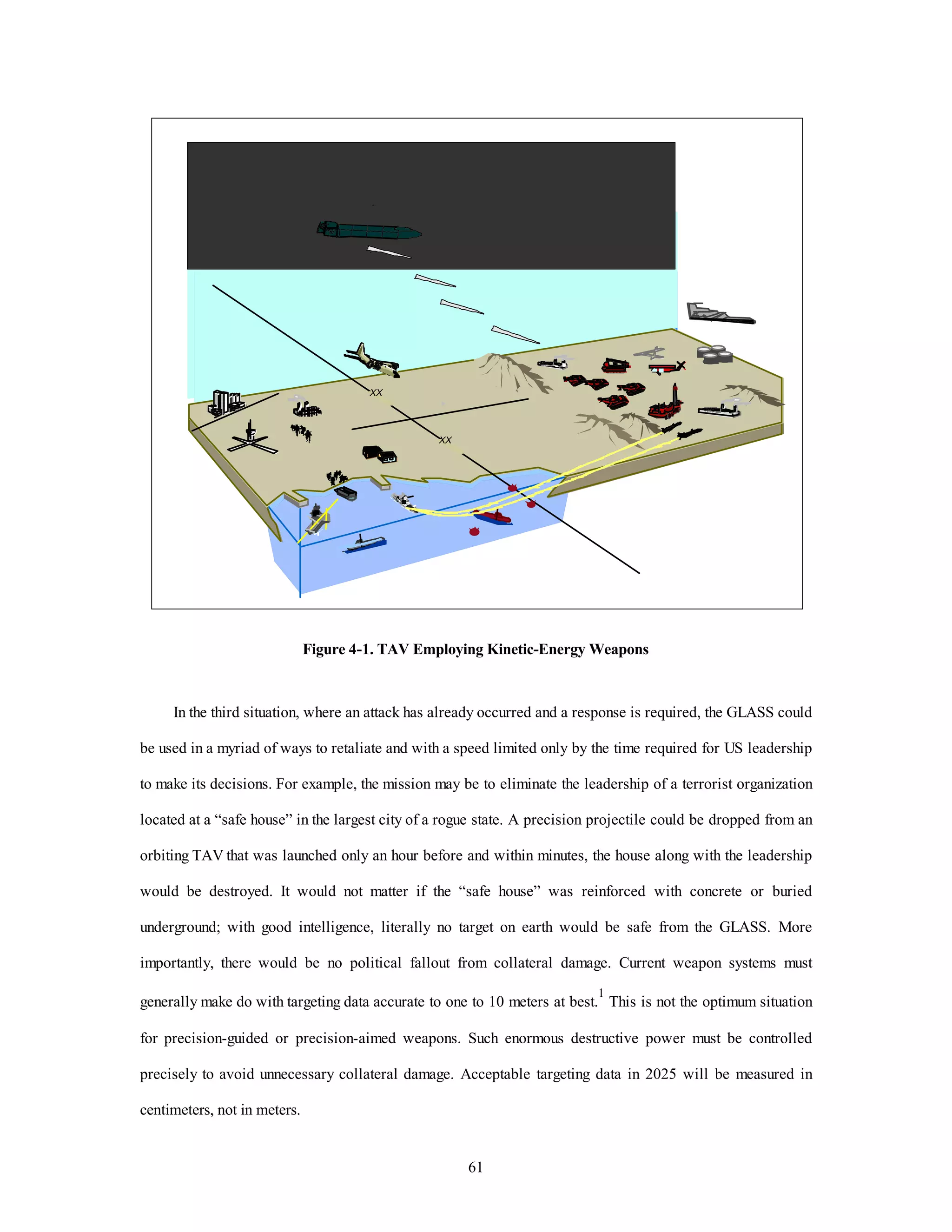
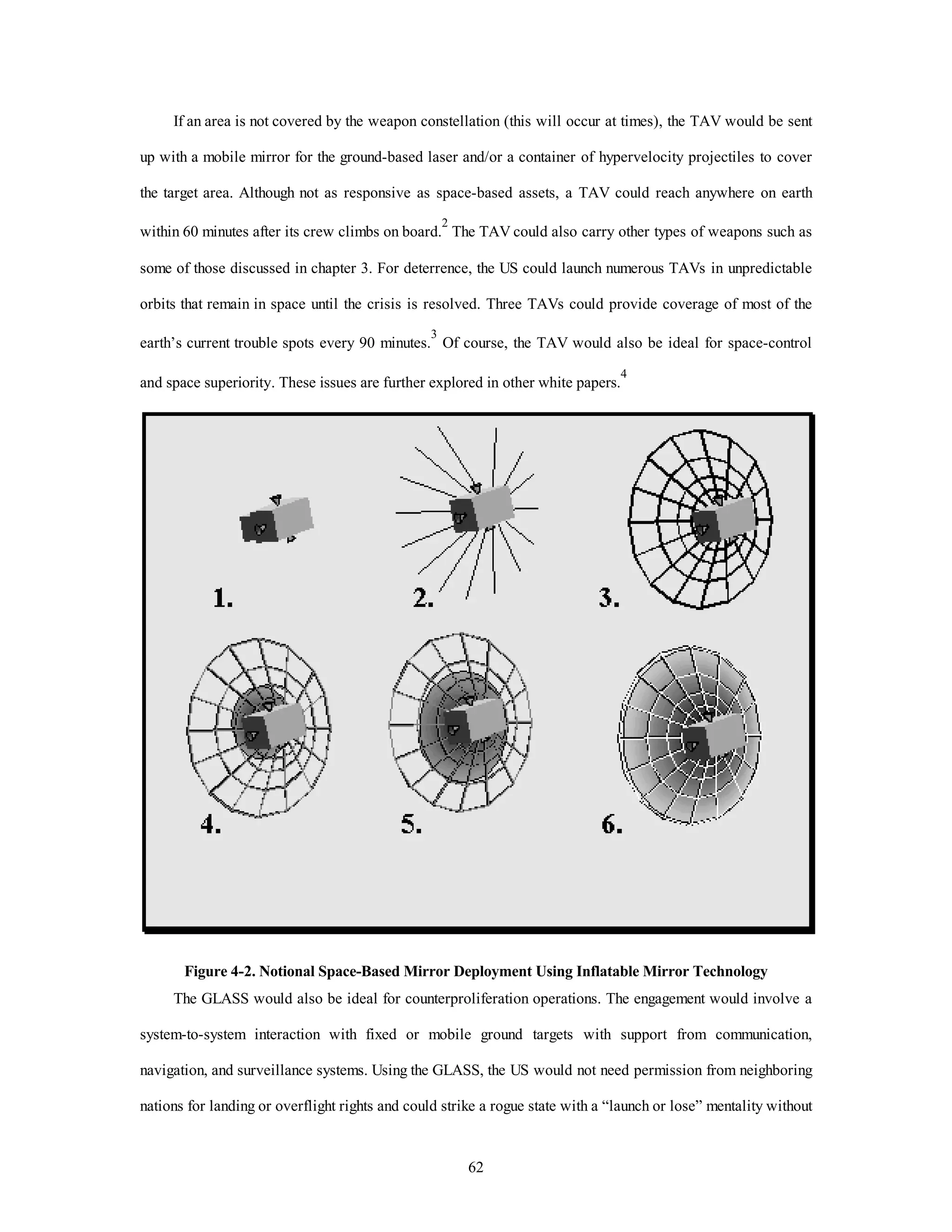



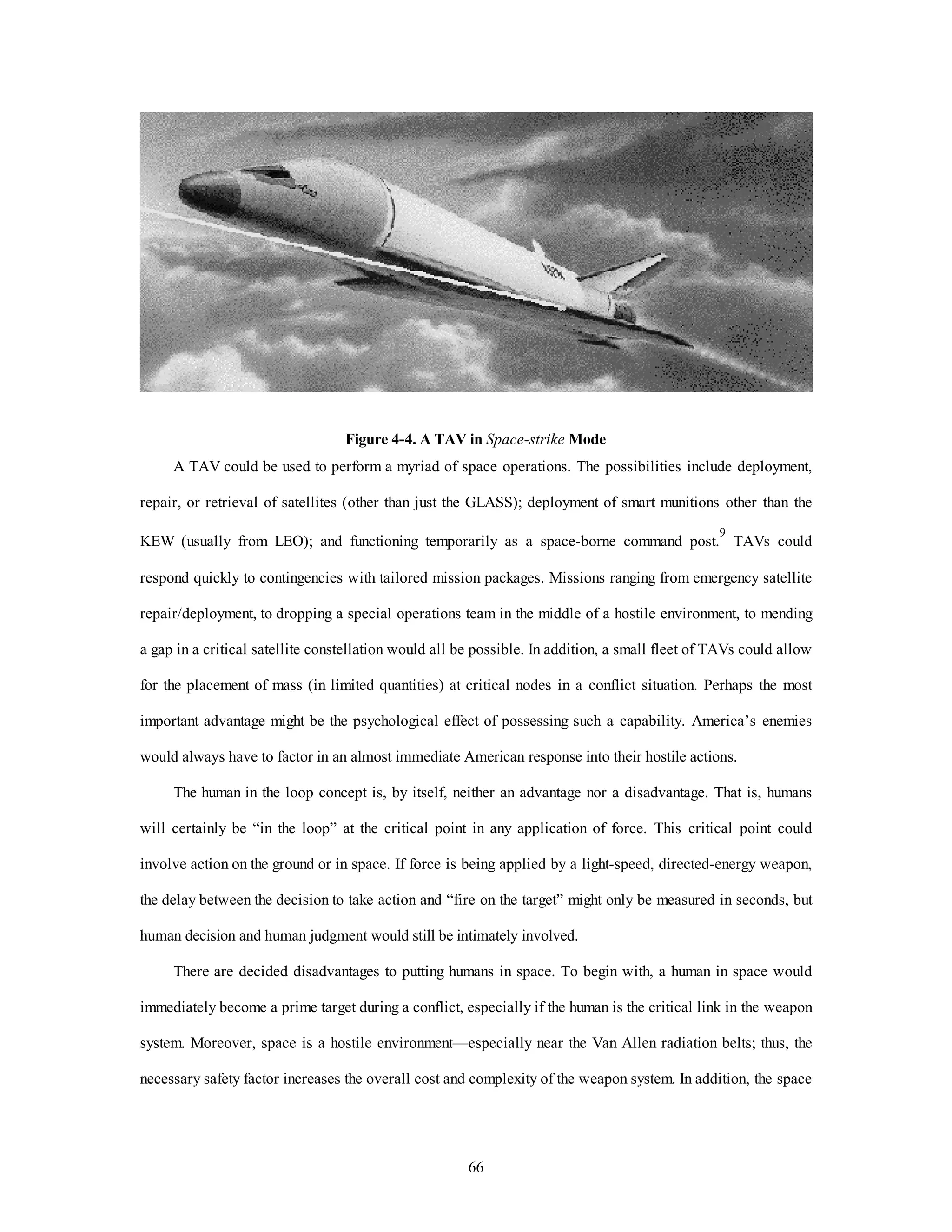
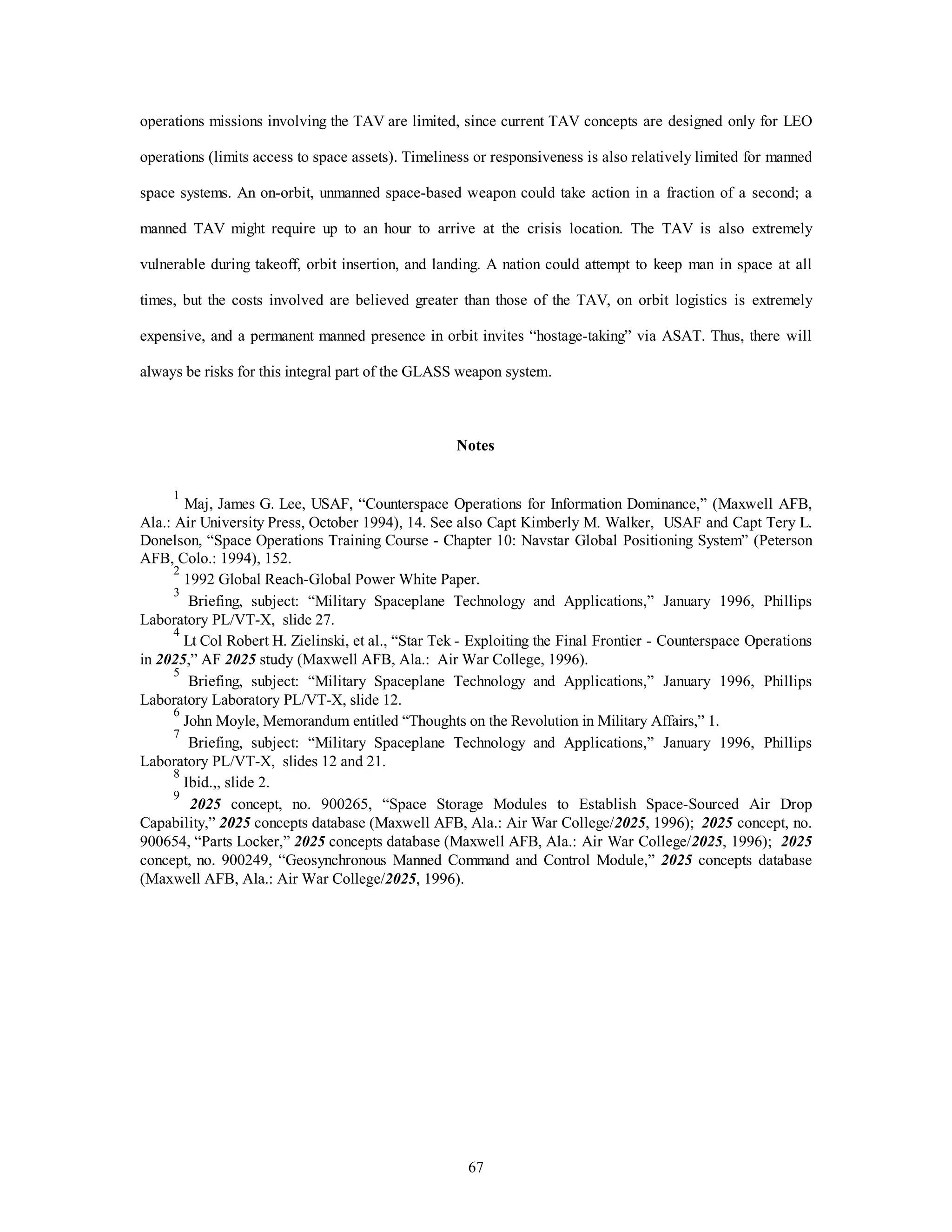
![Chapter 5
Investigation Recommendations
We know from even the most casual study of military history how fallible man is in
matters concerning war and how difficult it has been for him, mostly because of the
discontinuity of wars, to adjust to new weapons. Yet compared to the changes we
consider now, those of the past, when measured from one war to the next, were almost
trivial. And almost always in the past there was time even after hostilities began for the
significance of technological changes to be learned and appreciated.
68
—Bernard Brodie1
The concepts discussed in this paper directly address the needs of the military’s most forward-thinking
senior planners. Volume four (Future Capabilities) of Joint Planning Document FY 98-03 states that, to
achieve joint war fighting objectives, we must develop the “capability to destroy selected targets with
precision while limiting collateral damage. Includes precision guided munitions, surveillance and targeting
capabilities. Requires advances in sensors, guidance and control, and lethality.”2 Joint Vision 2010 calls for
“long range precision capability, combined with a wide range of delivery systems . . . the
ability to generate a broader range of potential weapons effects, from nonlethal to hard
target kill . . . these improvements will result in increasingly discrete and precise
capabilities, selected to achieve optimum results and applicable to both combat and other
operations.”3
The New World Vistas team predicts “space-control and projection of force from space technologies will
become as important [as global observation and global situational awareness] in the twenty-first century as
global technology for utilization of space becomes more available to many countries of the world.”4
Achieving these desirable capabilities will not be easy and it will not happen overnight. We must begin work
now if we wish to be ready for the world of 2025.](https://image.slidesharecdn.com/vol3ch14-140914105123-phpapp02/75/Vol3ch14-76-2048.jpg)

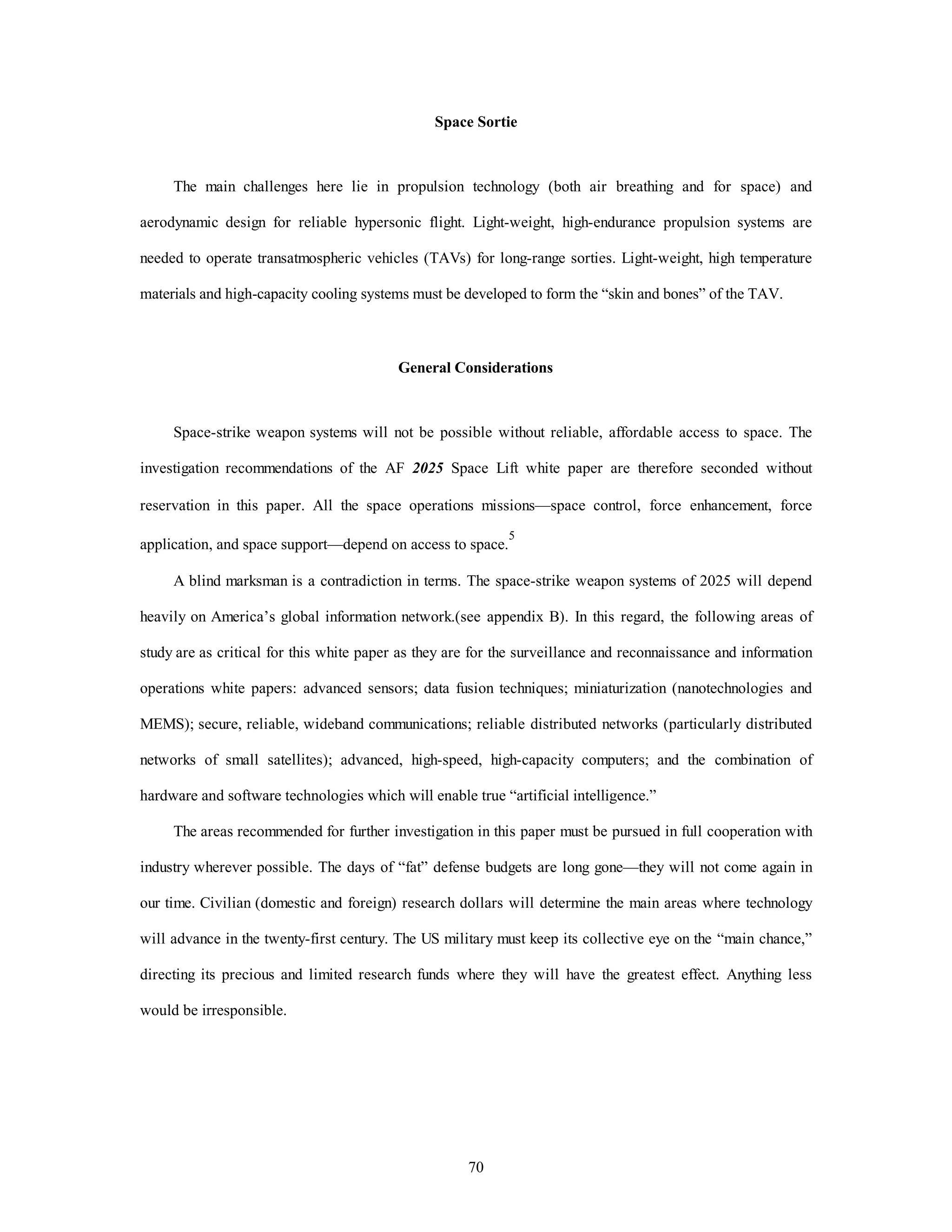


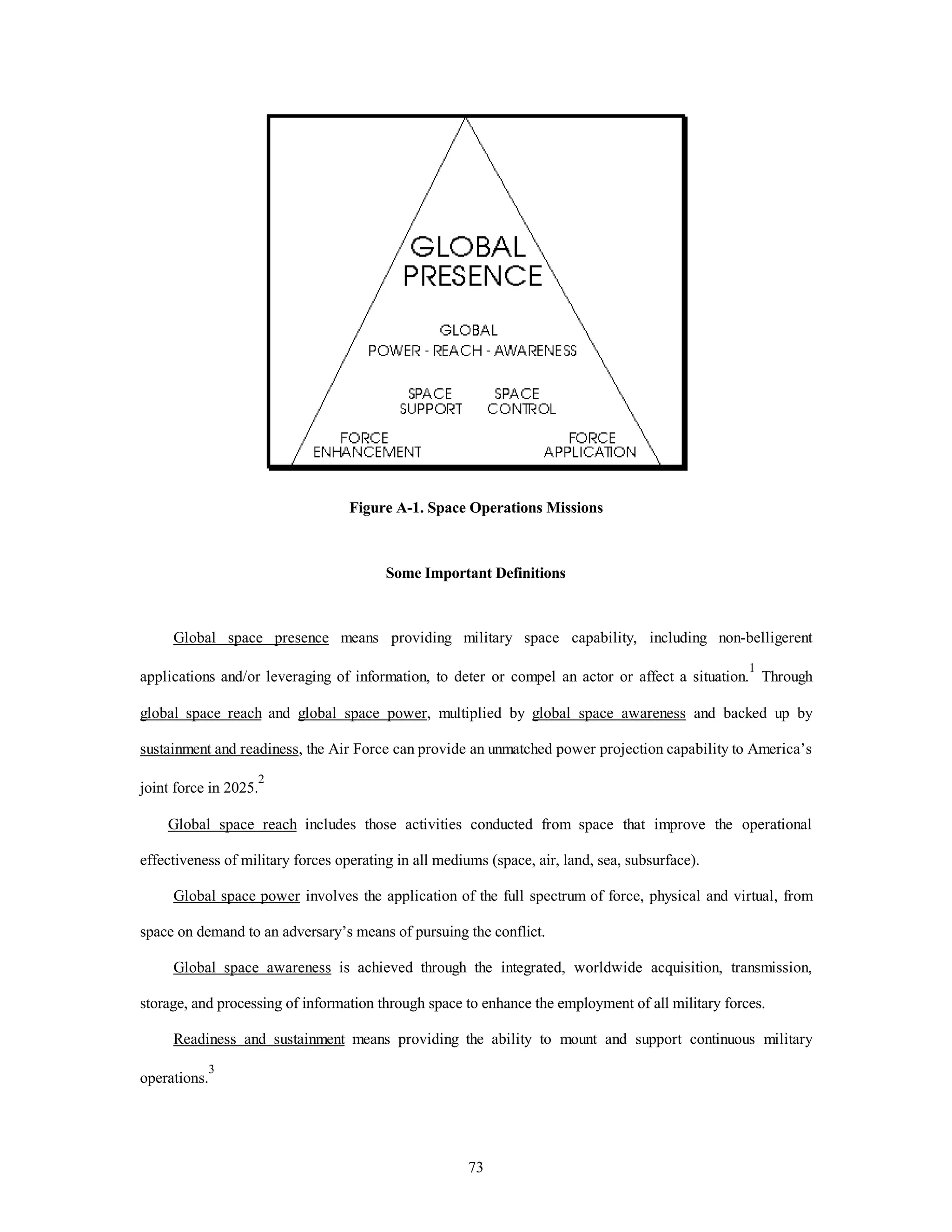
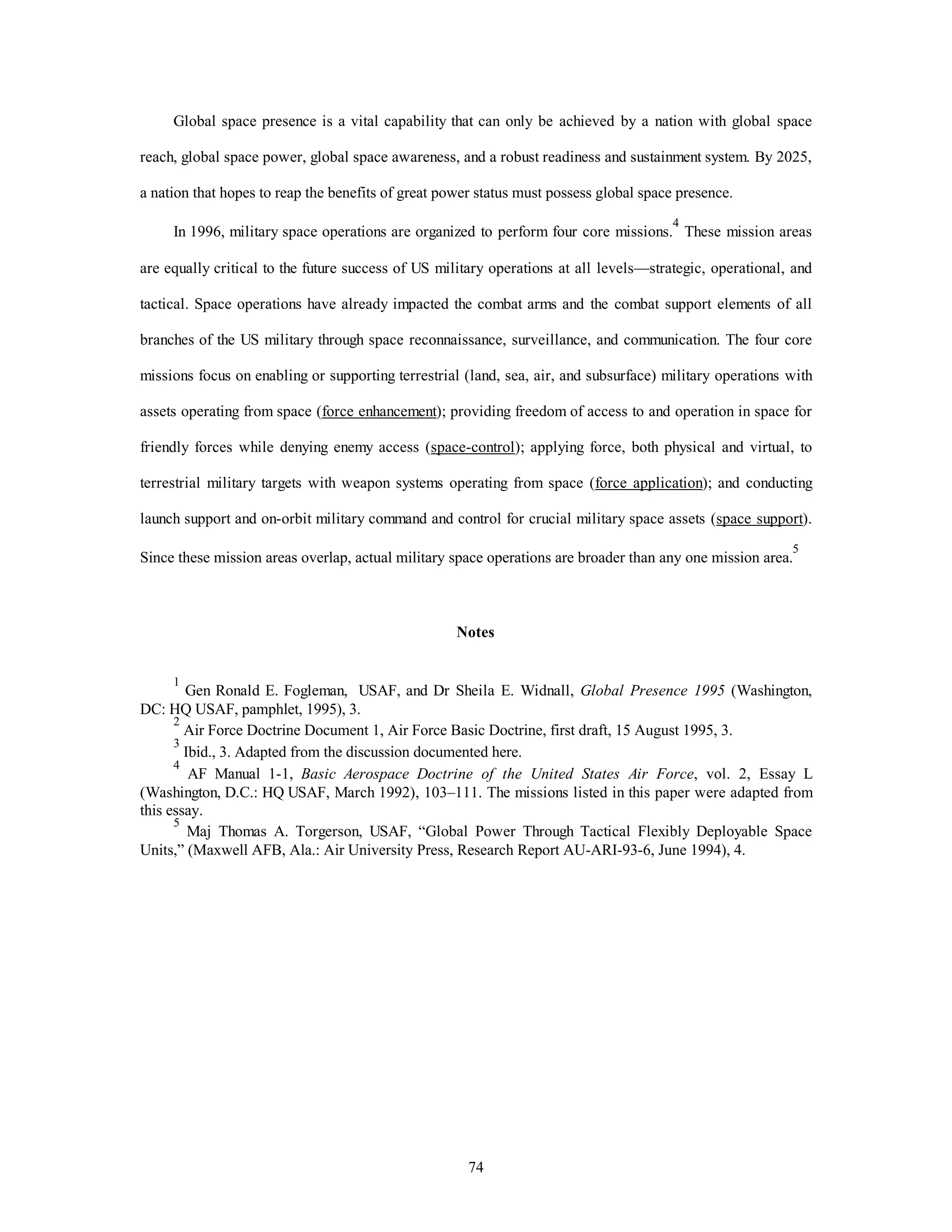
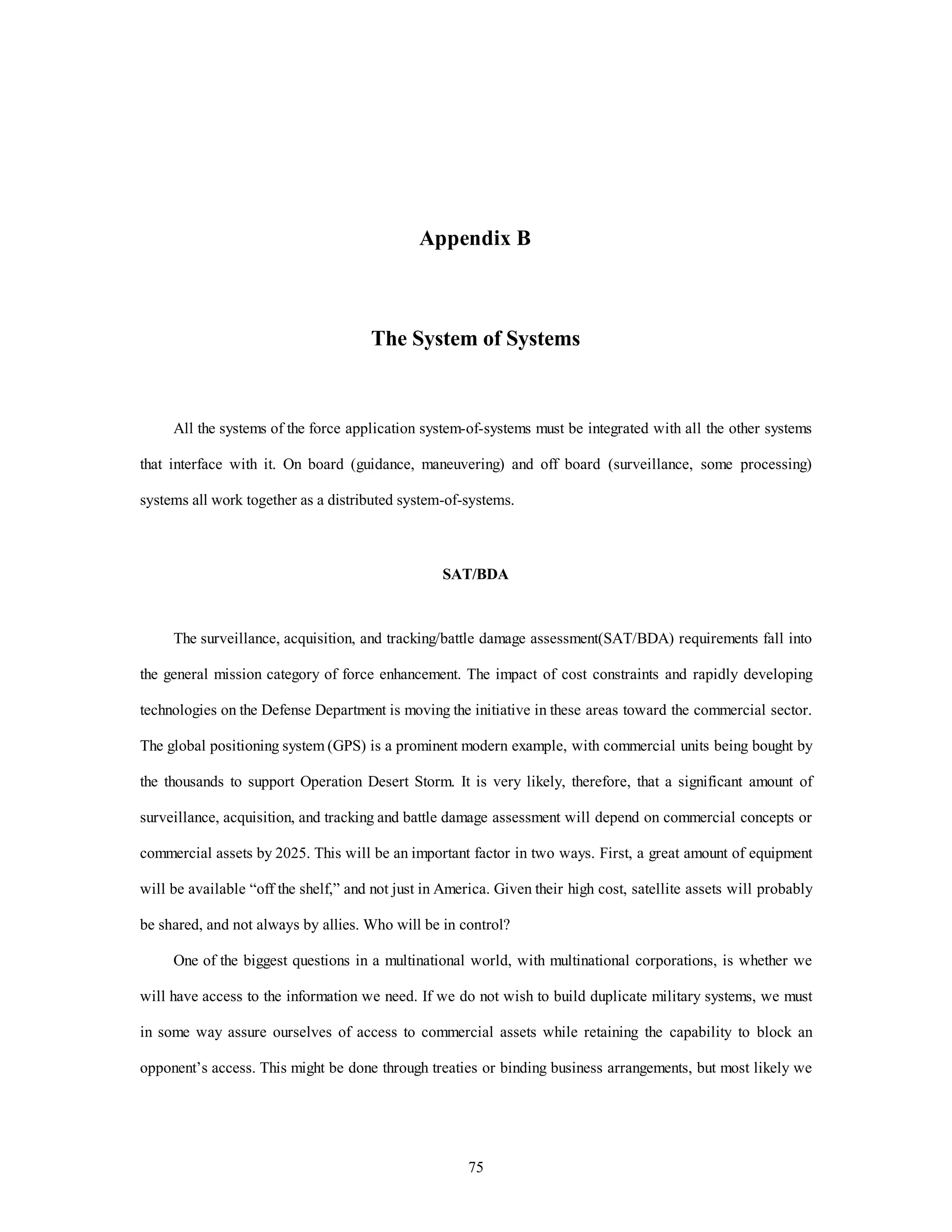
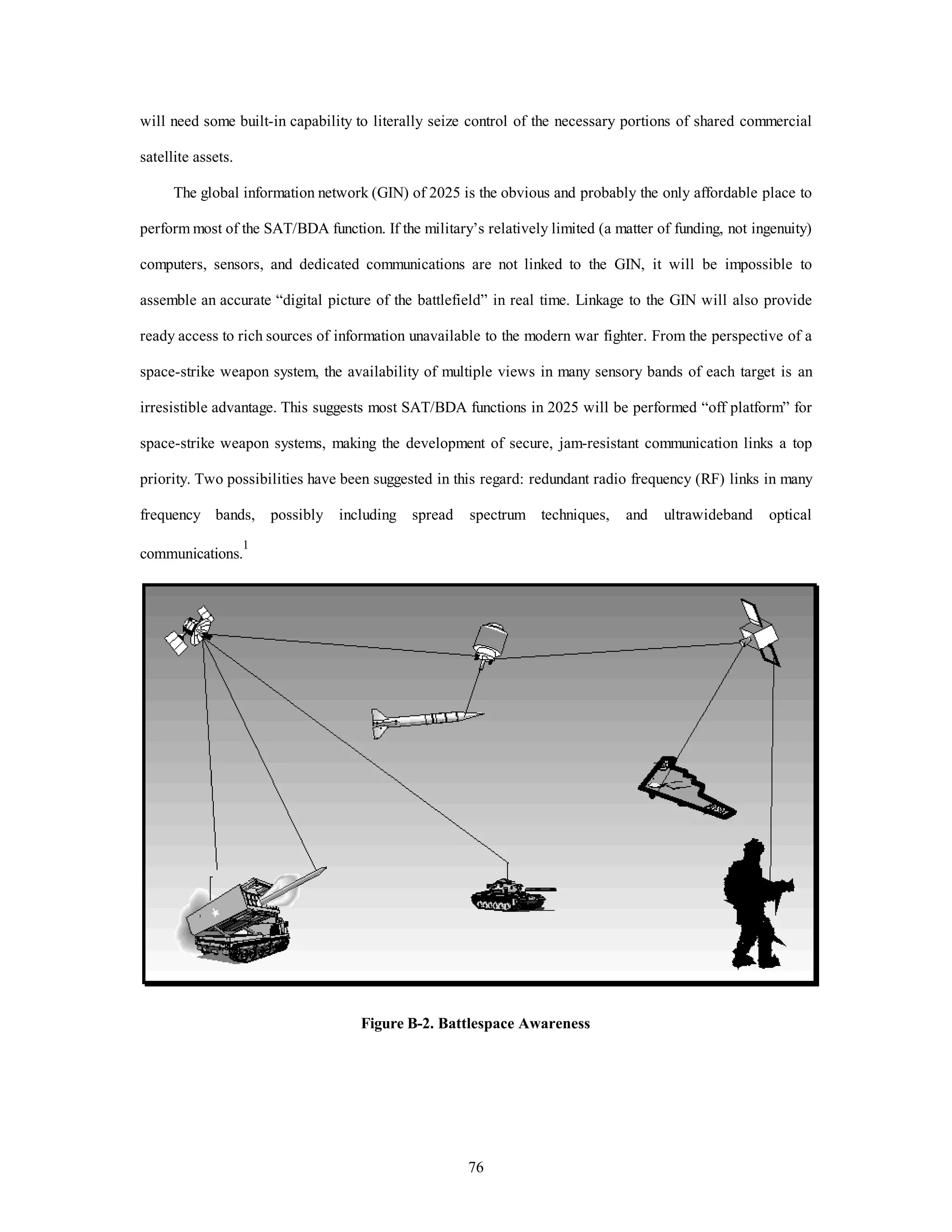
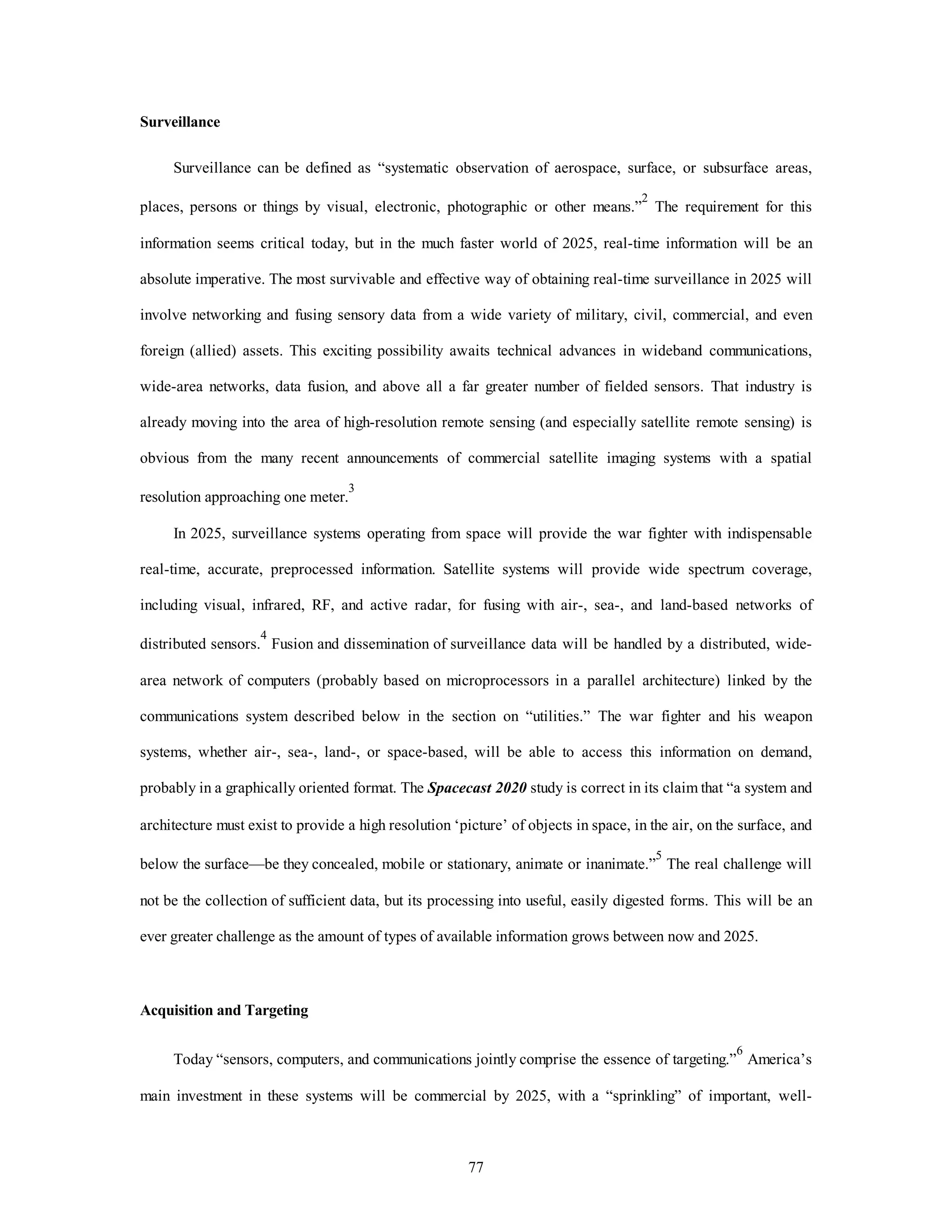
![protected (hardening, stealth, CONUS basing, deception), military-only or military-priority assets. This
dispersion of assets will be an advantage, since properly designed, distributed systems are much more
survivable than centralized, dedicated systems, and because it may be impossible to determine which portion
of which physical asset is being used by the military at any one time. Surveillance and acquisition functions
can and should, therefore, be provided by “off platform” distributed systems.
Targeting is a more complex and specialized function. By 2025, automated target acquisition and
identification will finally be a reality. The necessary databases and specialized information processing assets
can be made available through the GIN, which will also be linked to any specialized military sensor data that
might be required to deal with particularly difficult targets. Automated target acquisition and identification is
the subject of intense research today, and many promising approaches are being investigated on conventional
supercomputers and clever, proprietary combinations of electronic and optical computers.7 Commercial
satellite remote-sensing systems are already in development with spatial resolutions good enough to identify
aircraft, surface ships, land mines, and most smaller vehicles.8 The results of the primarily off platform
acquisition and targeting functions will then be handed off to the weapon platform, which will provide the
78
tracking and force-application functions.
The Spacecast 2020 special study discusses a similar approach. “With appropriate algorithms and
beam selection, it is conceivable that the entire sensor constellation could be available for collection all the
time. Fusing of the reflected data from a single “taste” [speaking metaphorically] would take place on a
central platform, probably in geosynchronous orbit.”9 By 2025, there will be no need for a vulnerable,
central collection platform. With the continual miniaturization of computers and electronics, improved
network hardware and software, and redundant wideband communication links (both optical and RF) these
data collection and fusion can and should be shared among a variety of platforms, space and earth-based.10
This approach has the enormous advantage of eliminating critical nodes in the US military information
system.](https://image.slidesharecdn.com/vol3ch14-140914105123-phpapp02/75/Vol3ch14-86-2048.jpg)
